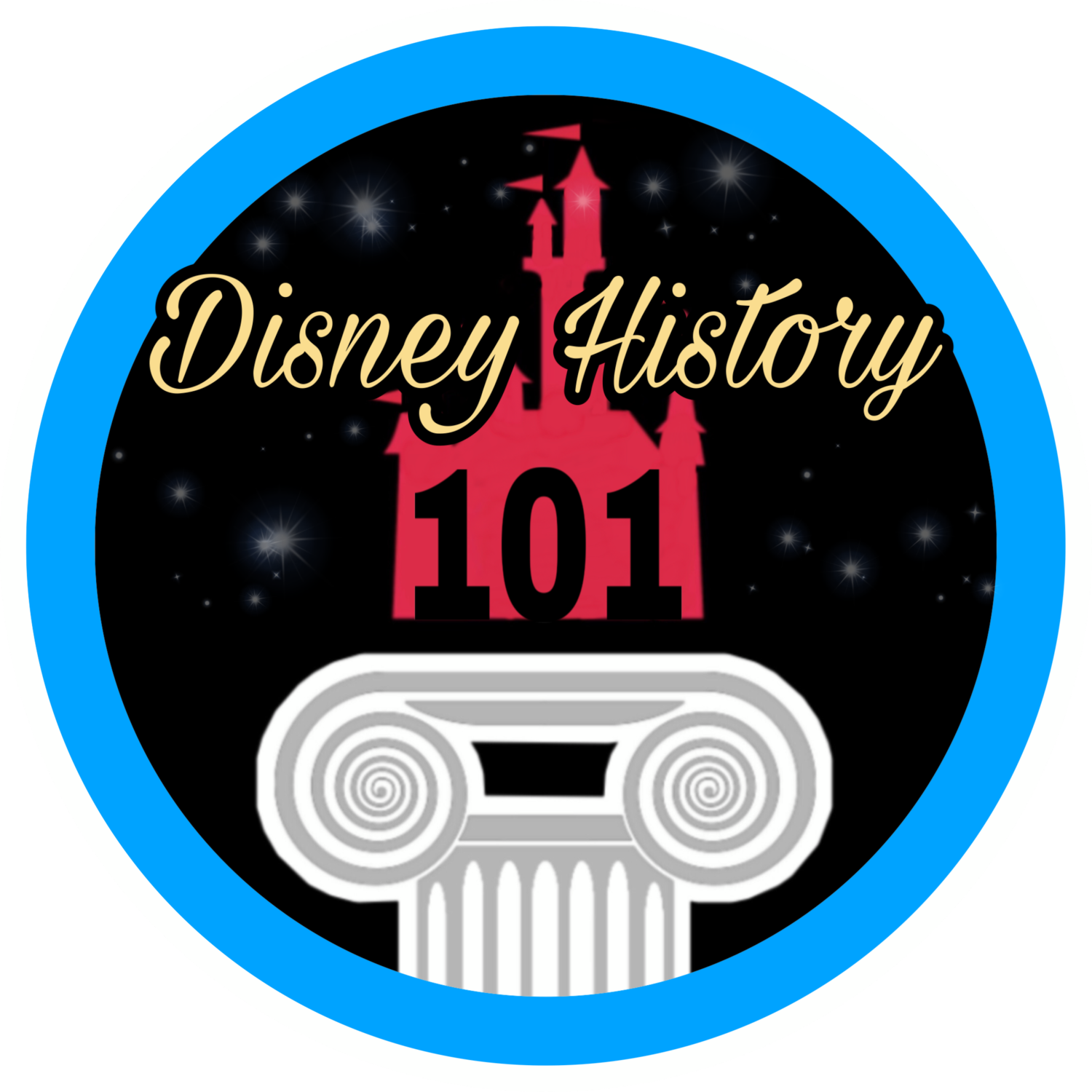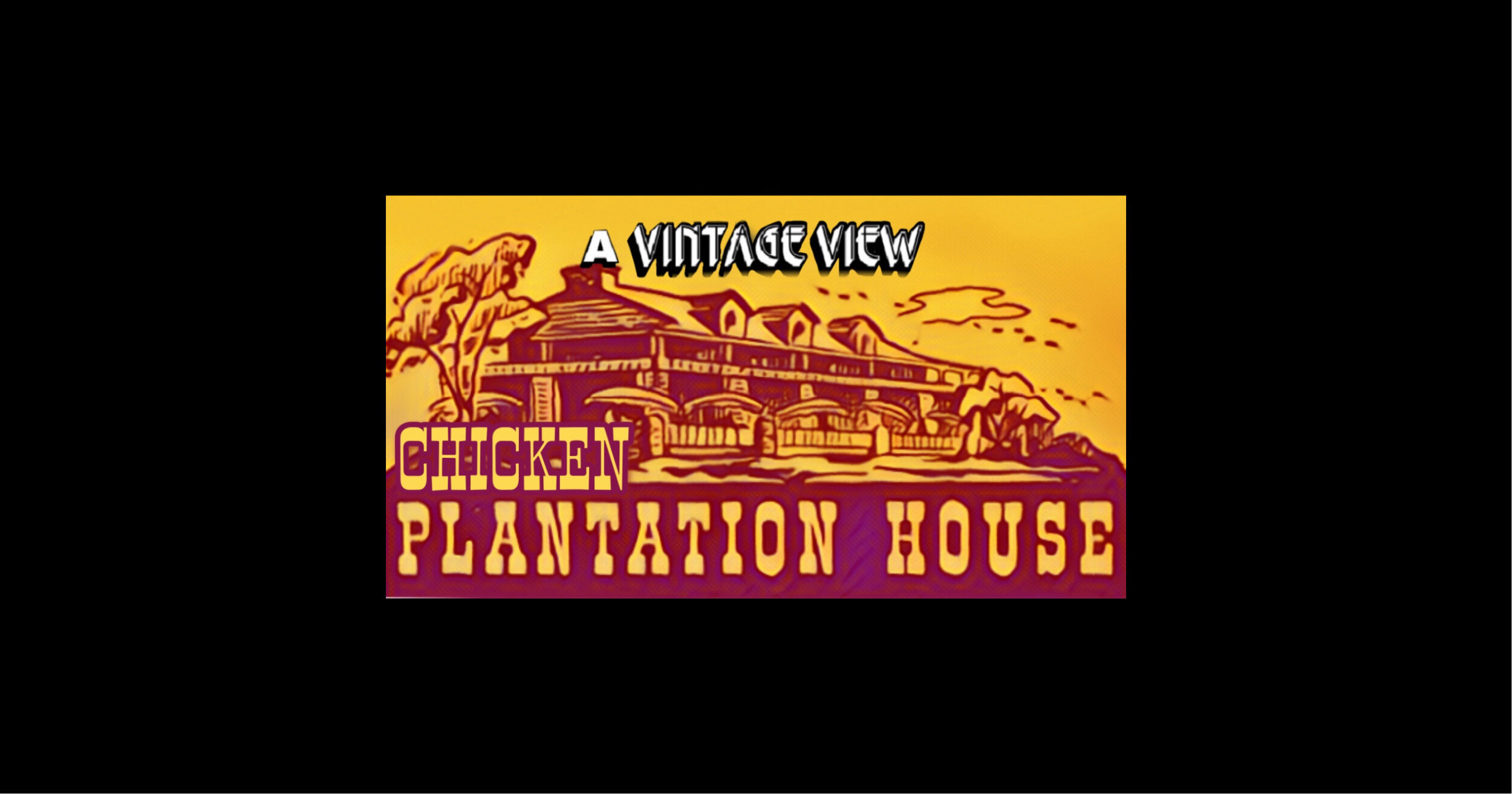CHICKEN PLANTATION RESTAURANT
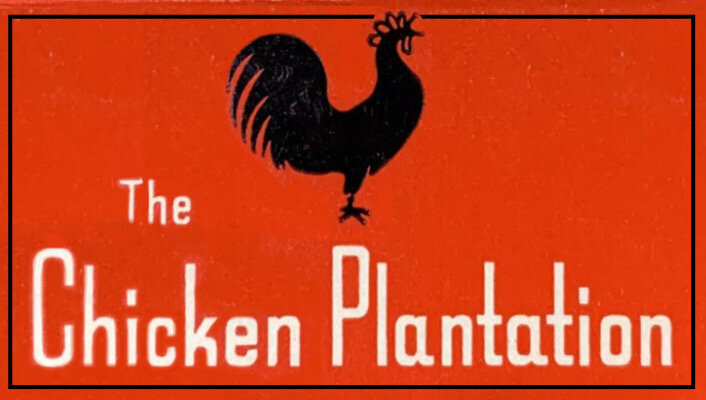
(July, 1955 - January 8, 1962)
According to “THE DISNEY THEME SHOW - an introduction to the art of Disney outdoor entertainment: Volume II”: Of all the guests’ senses that come into play at Disneyland, the most difficult response to predict was taste. If 70,000 guests were to arrive on a single day, there would probably be 70,000 different ideas about food. Generally speaking, Disneyland food locations fall into three categories - sit-down restaurant service, “buffeteria,” and fast-food categories. The most extensive theming has always been found in the sit-down restaurant locations but all locations were housed in authentically motified facilities.
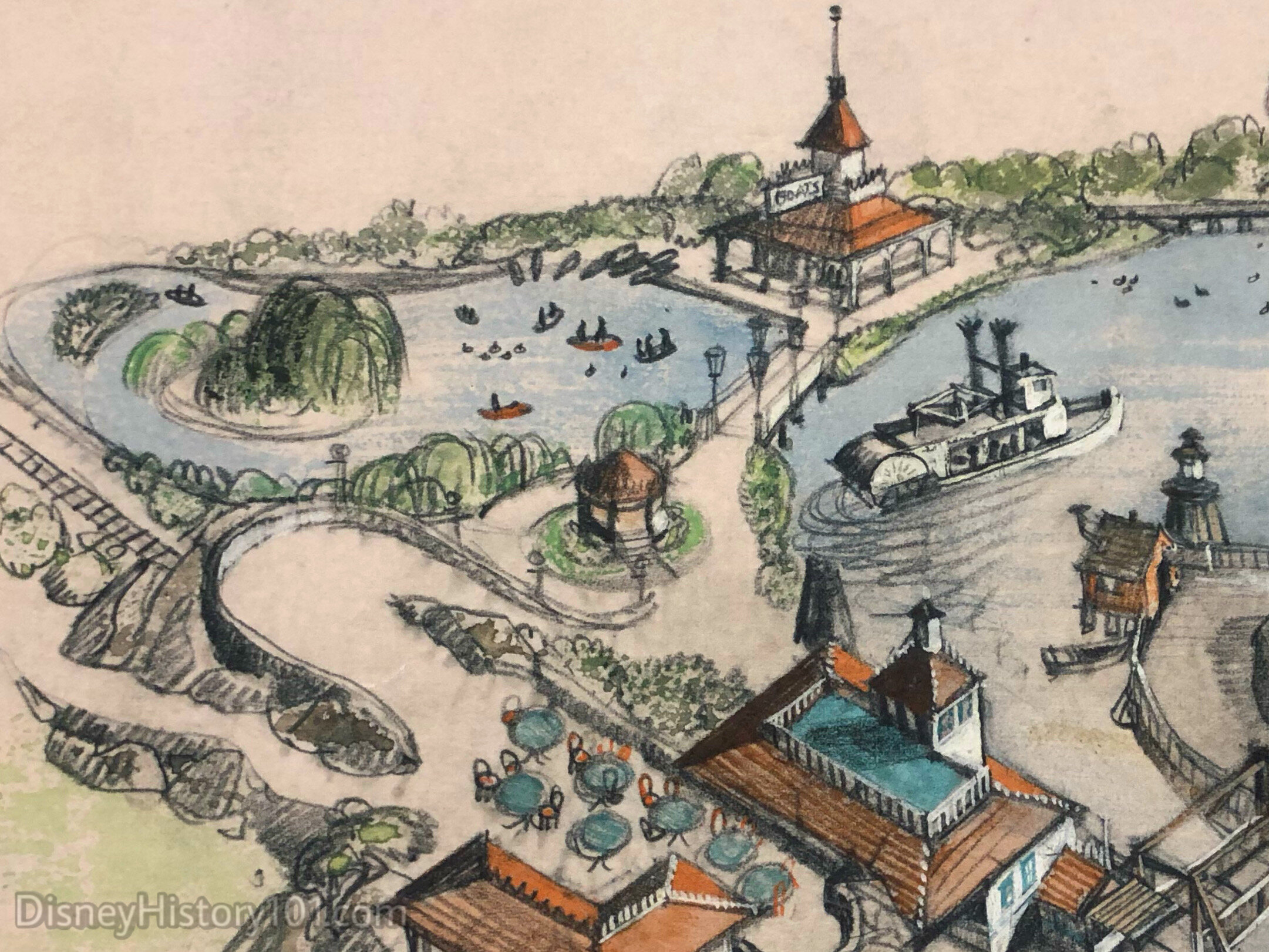
"Mickey Mouse Park" Concept Art by Harper Goff.
Early thumbnail sketches and other concept artwork of Mickey Mouse Park seemed to be unencumbered by restrictions of budget, schedule or the laws of nature and physics. Though guided by Walt, his artists appeared to engage in “free-thinking,” as if implementing the modern “Blue Sky” Imagineering process. Some of the earliest concepts of a “Mickey Mouse Park” (which was to be located on a 11-acre triangular plot across from Walt Disney Studios in Burbank) featured a riverside restaurant from where one could watch the river traffic while dining (pictured above). Some of these viable project Concepts (as this), were supported by a well-developed business case and built expectation.
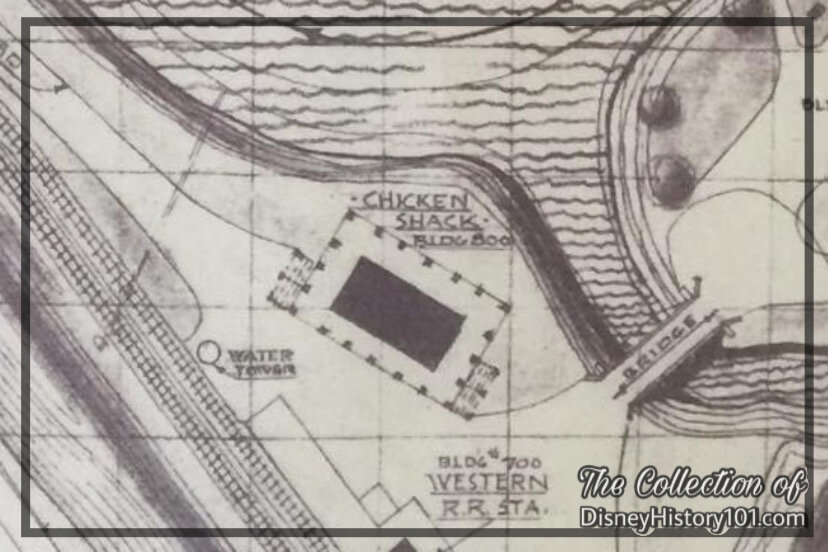
Marvin Aubrey Davis' "Plot Plan of Disneyland," (1953)
Early Frontierland concepts originally had a New Orleans Area in the character of New Orleans during the period up to the Civil War. Though anything resembling this concept seems to have been absent in Herb Ryman’s Aerial over Disneyland (originally produced September 26 & 27, 1953) that little “Chicken Shack” soon appeared in Marvin Davis’ c. 1954 Plot Plan (pictured above). Like some advanced “High Concept,” final designs were quickly generated and approved.
”Participant Sponsorship”
Meanwhile, Walt furthered the search for Participants who would lease shop and restaurant spaces at Disneyland. Such Disneyland Participants would help generate the necessary capital to fund construction and future growth of Disneyland. In a synergistic relationship, the companies (in turn) could sell their products and advertise their corporate names in the Park. Disneyland Participant Corporate Sponsors were carefully selected. High quality, long term corporate sponsors would provide incremental income that enabled Disneyland to enhance its show and attractions, offset some operating expenses, and capitalize on marketing opportunities.
“55er” Rima Bruce (who started with Jim D'Arcy in Food when all food was Lessee and typed memos and menus) recalled that “the phone never stopped ringing with everybody trying to get a food lease in the Park.“ Individuals like Nat Wyncoff provided the essential orientation for curious lessees, selling them on the idea of Disneyland using various visual aids like sketches and one of Herb Ryman’s oil paintings of Disneyland.
Soon, “a cross-section of American industry…[was] represented in Disneyland. Each of these companies… [would expose] its institutional advertising and public relations message to Disneyland guests through various forms of participating exhibits and displays. In each case, the exhibit… [was be] related to the theme of the ‘land’ in which it is located, and is woven into the overall concepts and themes of Disneyland”, according to “Disneyland, U.S.A.”, published 1958. Several of these “reliable old firms” sponsored the “abundance of restaurants devoted to pleasing all tastes and all budgets,” according to “The Story of Disneyland”, published 1955. A prime example was the Chicken Plantation House, operated by the Red Wagon Company!
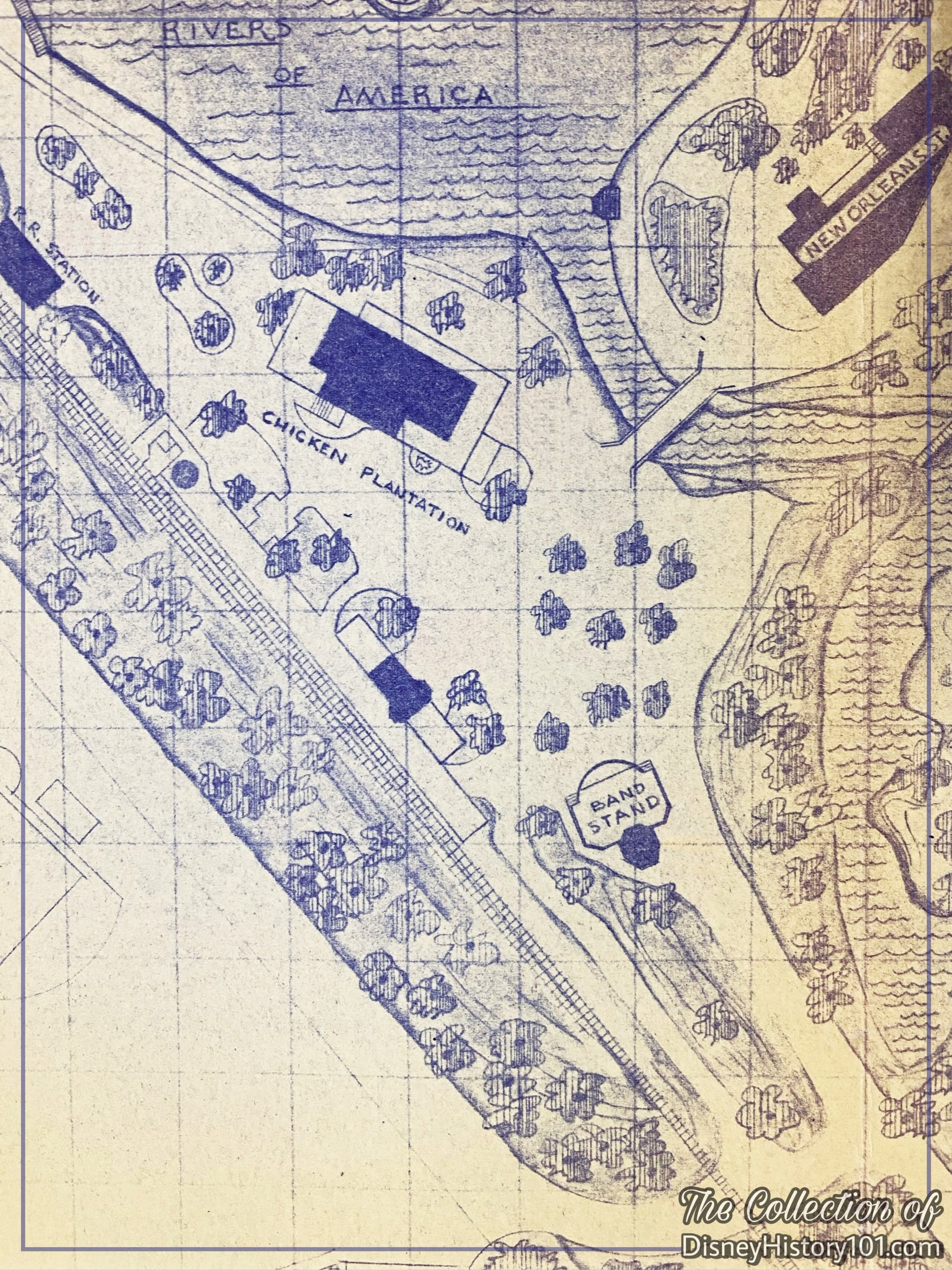
Note the “Chicken Plantation” on this Plot Plan of Disneyland designed by WED Enterprises, Inc. for Disneyland Inc.; received by November 13, 1959.
“Design & Construction”
Next, architectural drawings helped define all designs, production and construction strategies, costs, schedule, and resource requirements. F.M. Franz, manager of operations for McNeil Construction expressed: "We feel sure there has never been anything built like this in Southern California, or elsewhere in the United States. Many of the items were constructed from artist’s sketches.”
The Chicken Plantation House was designed and constructed as a two story, wood frame-stucco restaurant building with a dining room, kitchen, storage room, two 2-fixture lavatories on the ground floor, a dining room, kitchenette, and a dressing room. Guest Services and Accommodations included restrooms with three lavatories with 8-fixtures in the rear of the Plantation House on the second floor, and telephones in the rear of Plantation House.
The structure was built atop a concrete foundation and floor slab, with wood shingle and roll composition roof, interior walls and ceilings of painted plaster except in the upstairs dining room which was wood paneled. The 3,492 square feet of floors were composed of asphalt tile. There was a covered 1,084 square foot balcony. About 1958, the entire facility was appraised and valued at approximately $37,250.00.
According to inserts published in area newspapers during July of 1955, Disney buildings were roofed by Pioneer Roof & Shingle Company (then located at 608 Mateo Street, Los Angeles, California; 7522 Westminster Avenue, Westminster, California).
As of June 2, 1955, C.V. Wood Jr. sent an Inter-Office Memorandum to Walt Disney regarding the best estimates that could be obtained at the time regarding the completion status of individual sections of the Park and Opening Day. C.V. wrote: “Plantation Restaurant: This one will be very close. They have an excellent chance of making it if they are not held up on procurement of fixtures and equipment.”
Chicken Plantation House was predicted to serve a capacity of 450 guests per hour, contribute to accommodating“15,000 persons daily, hitting a peak of 60,000 o holidays and week-ends…” and one of “twenty restaurants and snack bars, capable of saving 8,000 hourly,” at least according to “Building A Dream” (prepared by the Disneyland, Inc. Public Relations Department). Later, in 1958, Bank of America appraisers figured of the total income of Disneyland Inc. was received from such leases, 16.02% was derived from the selling of advertising rights and 40.12% from the leasing of space to concerns whose main reason for occupancy is for advertising purposes. The remaining 43.86% of the lease income was derived from stores that sell various products and food.
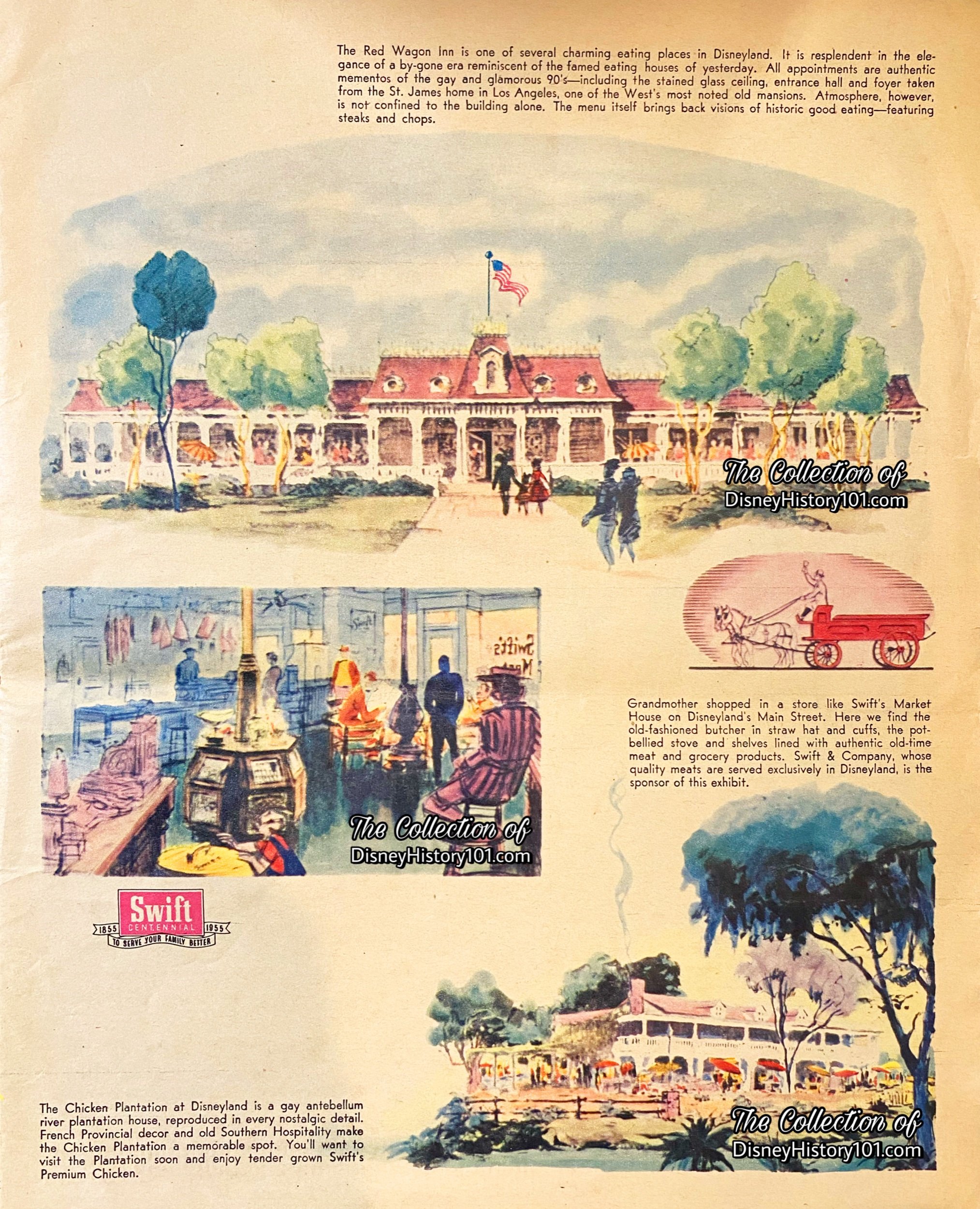
Chicken Plantation preview in a “Disneyland” Excerpt published July 15, 1955
On July 17th, 1955 (otherwise known as Disneyland’s Press Day), the Chicken Plantation table service restaurant was draped in the same patriotic bunting and banners that decorated the Mark Twain. The reason was that the Chicken Plantation House was to first be utilized as a Stage for an elaborate New Orleans-inspired dance number (before the eyes of both guests and Staff) to the melodies of the Firehouse Five Plus Two. Some of these things are preserved through Opening Day documentation.
Then, the 1,756 square foot restaurant opened its doors, and Disneyland “made arrangements for food and refreshments” for the members of the Press (and their family) at their choice of one of three restaurants (one of which was “Swift’s Chicken Plantation in Frontierland”). After dining, Complimentary cards were presented to the Chicken Plantation cashier after their meals.
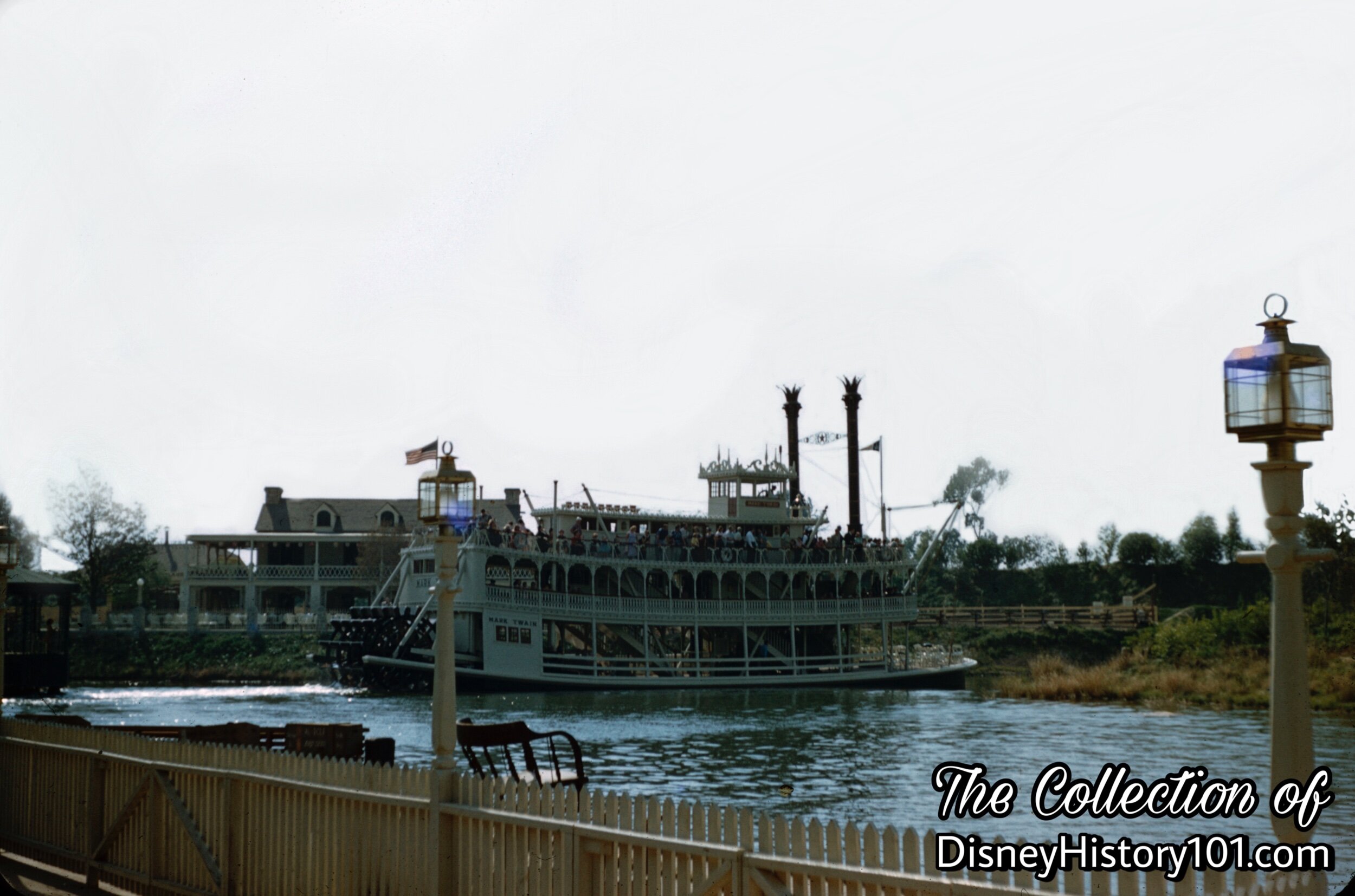
Looking Toward The Chicken Plantation Restaurant From The Mark Twain Dock, (1956)
Soon, the Mark Twain Steamboat would pass Swift’s Chicken Plantation House Restaurant before heading deep into “Frontier” territory. While we wait our turn at the Frontierland Dock, the sound of Dixieland and smell of Fried Chicken and Swift’s Premium Brown ‘n Serve Sausage is carried on the warm summer air, making its way across the water to our location!
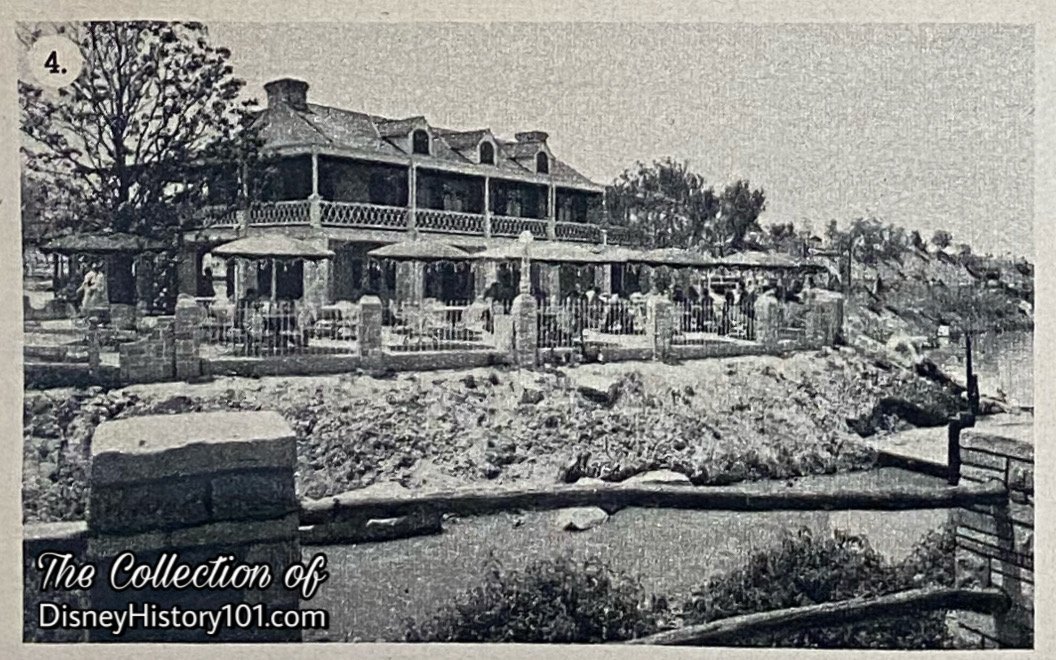
Swift’s Chicken Plantation House Architectural Facade was notably seen in “Disneyland 1st Anniversary Souvenir Pictorial”
“The Plantation Building does double duty. The side facing the river has the wide verandas, grille-work and graceful construction of early century New Orleans.”
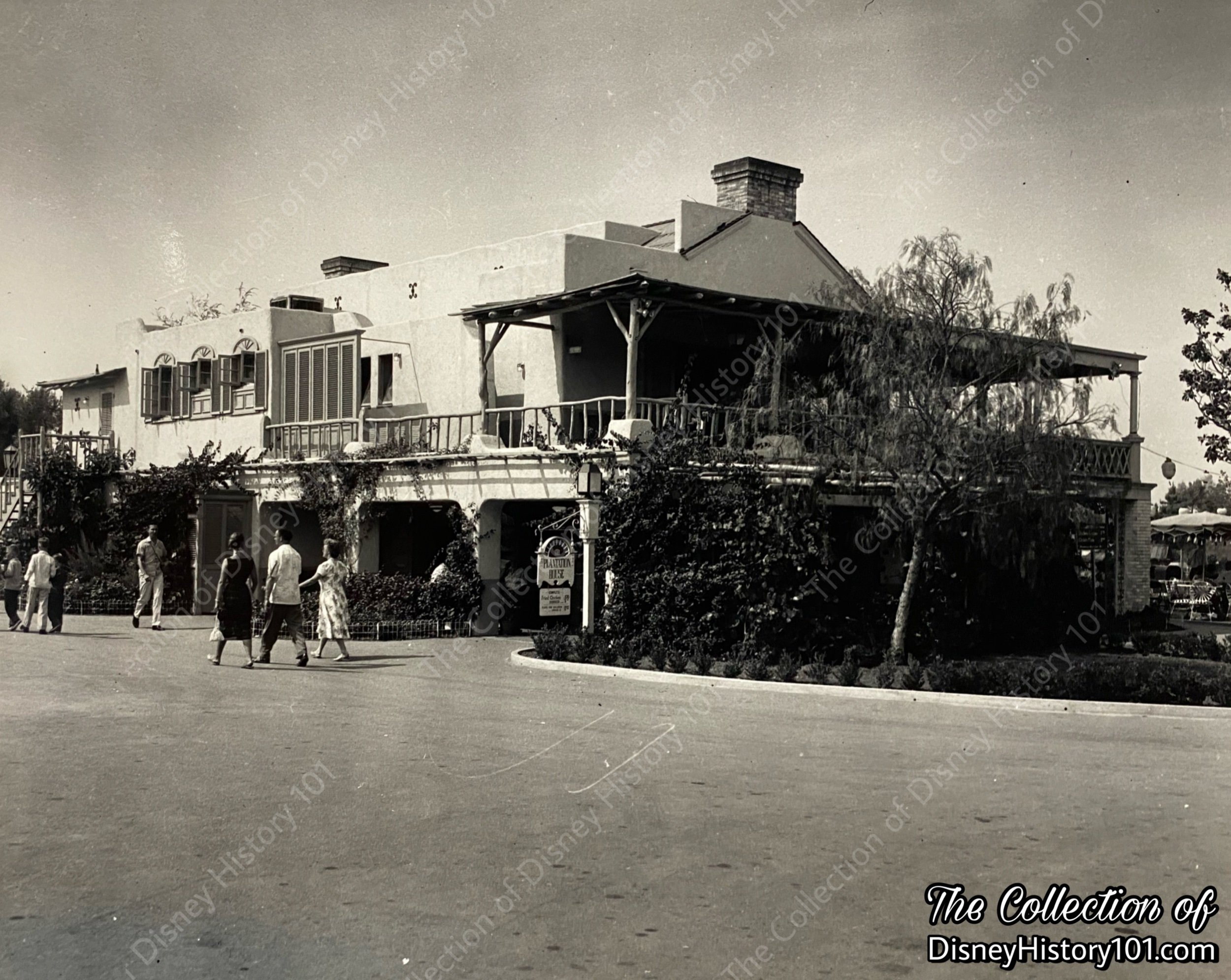
The Chicken Plantation House as seen in one press release photo; ©️Walt Disney Productions.
According to newspaper inserts published July 15, 1955: “The side facing the river has the wide verandas, grille-work and graceful construction of early century New Orleans, But the opposite, side of the building faces a scene from the old southwest - a stage' coach and a railroad station from America's colorful ‘Iron Horse’ era. This side of the restaurant has an adobe motif.”
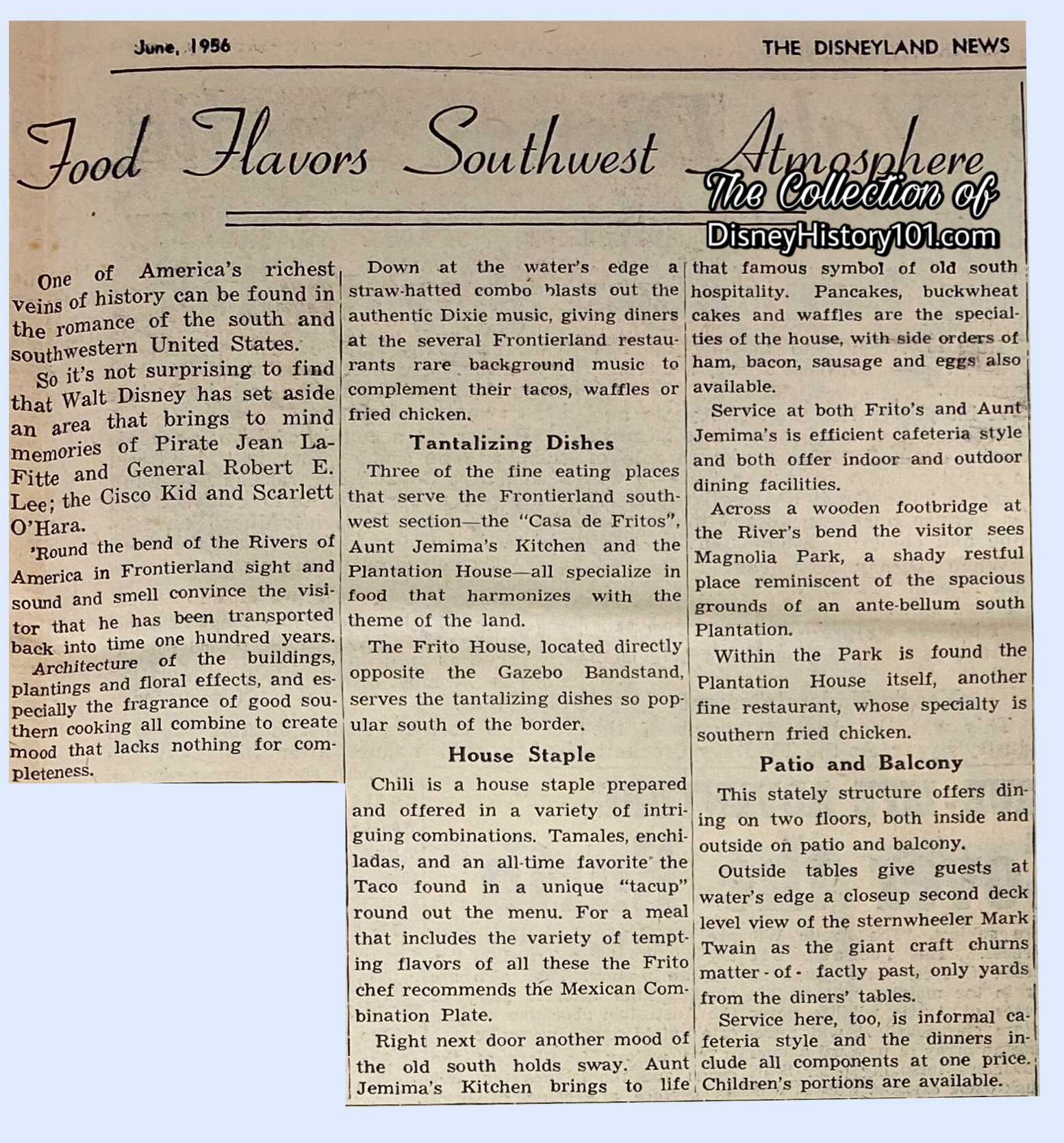
The Disneyland News Excerpt, (June, 1956)
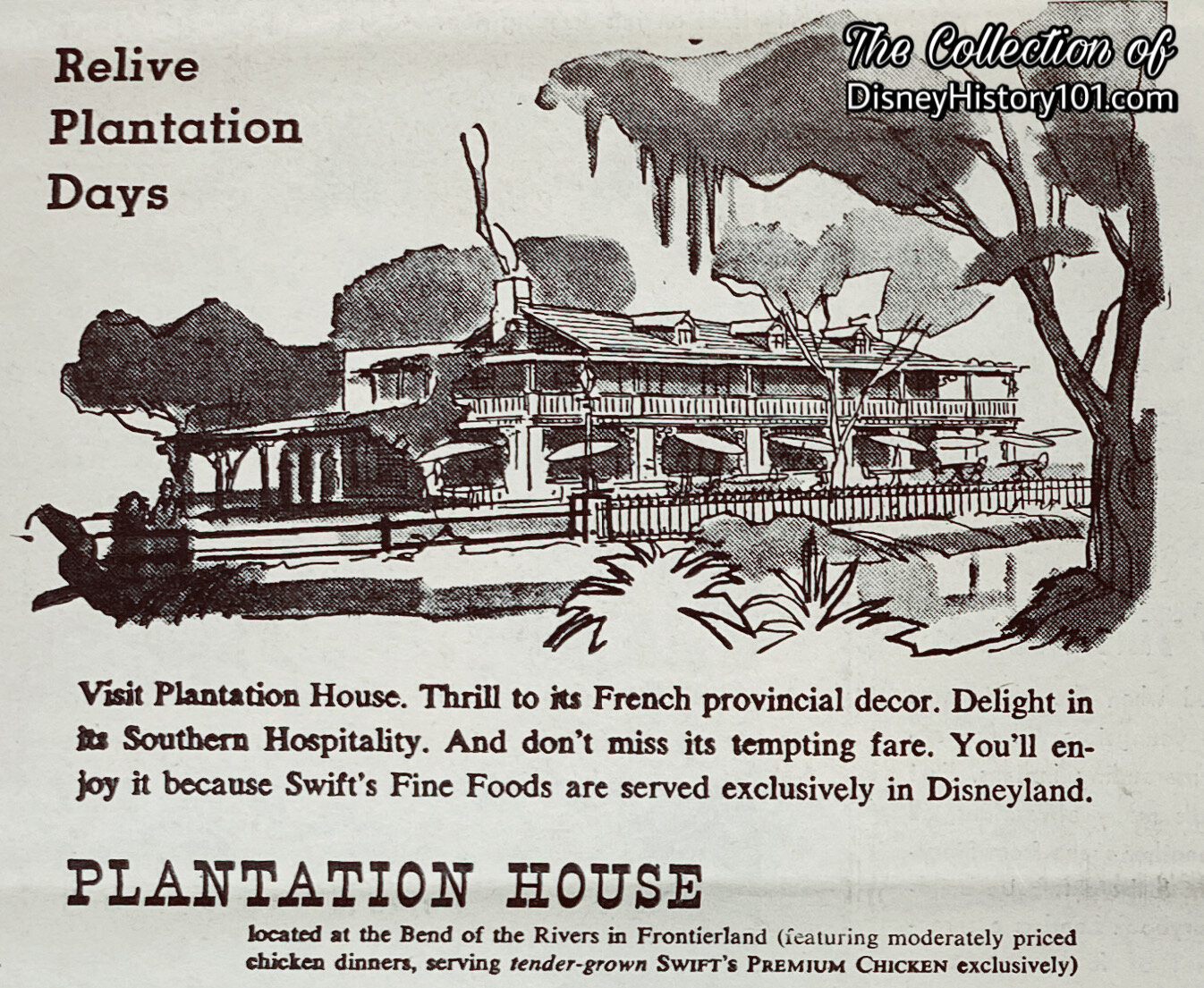
Plantation House Advertisement, published in Disneyland News, (June, 1956)
“Across the Bridge…”
Yes, “across a wooden footbridge at the River’s bend the visitor sees Magnolia Park, a shady restful place reminiscent of the spacious grounds of an ante-bellum south Plantation”, according to Disneyland News (June, 1956). Within this Park is found a choice place to “dine at Disneyland,” with a little Southern hospitality! You’ll note the atmosphere is delightful, provincial, and gay, while you find yourself surrounded by the French-antebellum decor of the Plantation House. The same publication continues : “The stately structure offers diners on two floors, both inside and outside on patio and balcony. Outside tables give guests at the water’s edge a closeup second deck level view of the sternwheeler Mark Twain as the giant craft churns matter-of-factly past, only yards from diners’ tables. Service here, too, is informal cafeteria style and the dinners include all the components at one price. Children’s portions are available.”
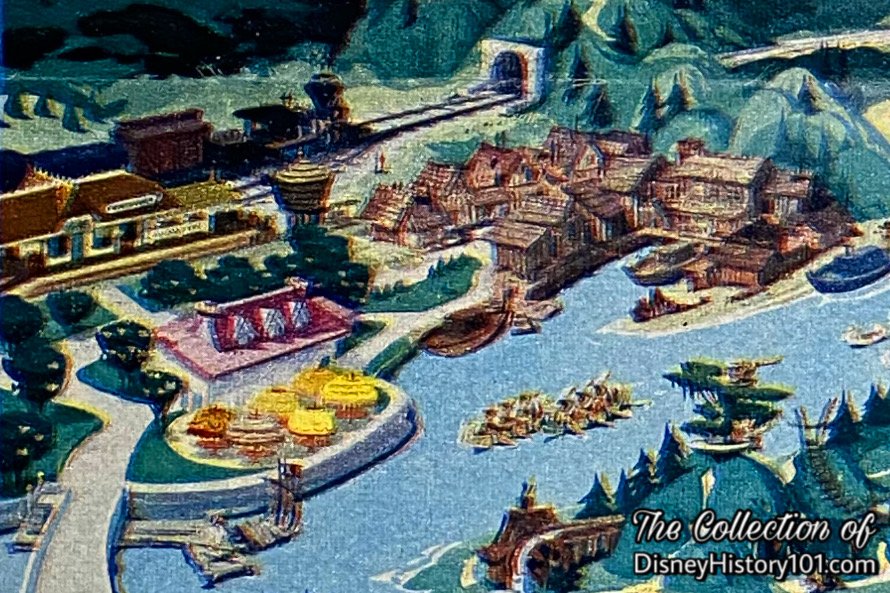
Magnolia Park included the Chicken Plantation Restaurant in this "Disneyland 1st Anniversary Souvenir Pictorial" Excerpt, (1956)
The structure was so photogenic, that it was occasionally utilized as a backdrop for photographs used for press-related materials or publication. Actress Spring Byington (of “December Bride) and child actor Bobby Diamond (of “Fury”) were photographed enjoying lunch here for their 1956 “TV Radio Mirror” photoshoot at Disneyland! During December of 1956, Swift’s Chicken Plantation Restaurant hosted the “Junior Ambassadors of the United States and Disneyland” (more than 30 boys and girls from foreign nations), providing “full-course fried chicken” meals.
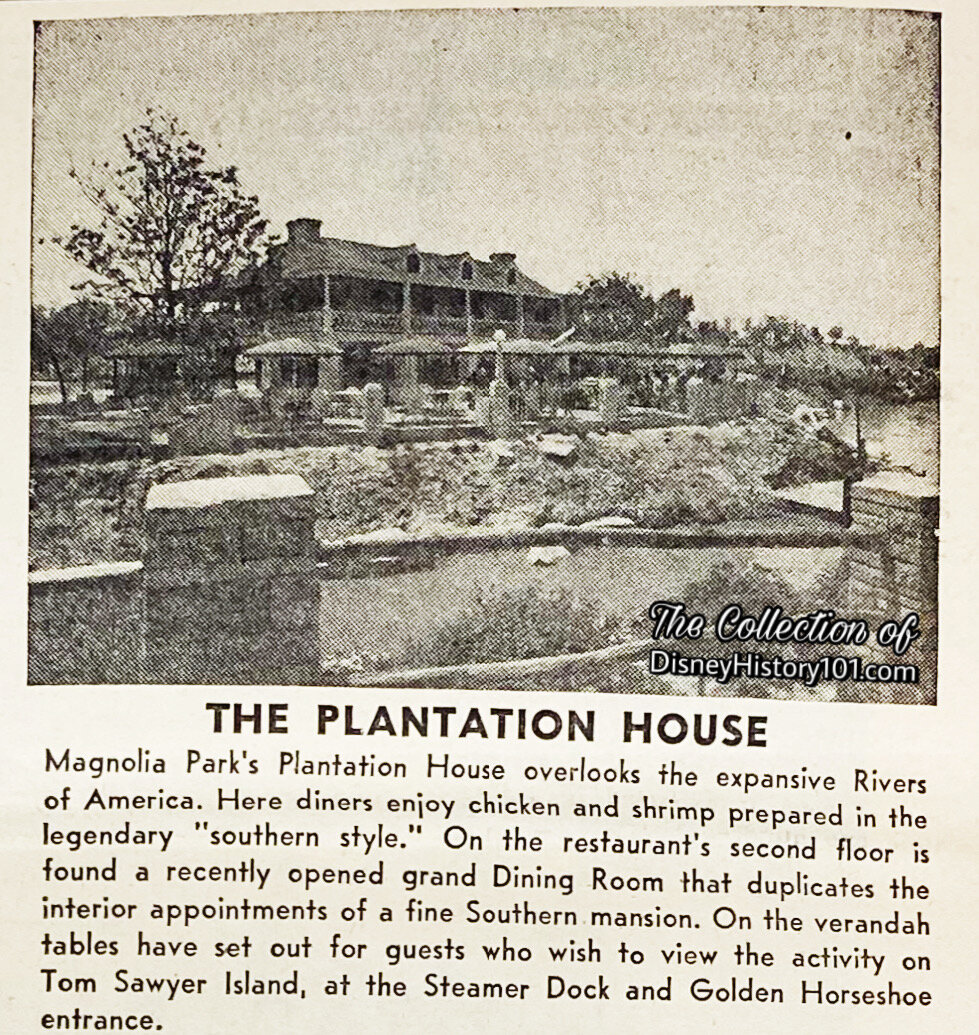
Disneyland News Excerpt, (June, 1956)
The Chicken Plantation House was operated by the Red Wagon Company, which also operated the Red Wagon Inn, Swift Market House, and the Snack Bar in Holidayland ( the latter under the supervision of Myrt Westering). As for Chicken Plantation House’s cuisine - enjoy tempting tender-grown Swift’s Premium Complete Fried Chicken Dinners $1.70, and Children’s Dinners started at $1.00. Yes, guests enjoyed tempting tender-grown southern-style Swift’s Premium Chicken dinners served from Swift’s Chicken Plantation House Restaurant. Customers received “dinners at a serving counter” and could “eat at umbrella-covered tables on the river bank or at tables on a patio.”
In a move of corporate synergy, the Chicken Plantation was one of 16 Disneyland “eating places” which featured “fine food with fine coffee - Maxwell House,” from 1955 to 1957! Carnation Farms would also serve this and 14 other wholesale customers who operated restaurants and snack bars in Disneyland.
Early notable Guests include the members of the “National Association of Amusement Parks, Pools, and Beaches”, which Disneyland hosted from September 18-20 (Tuesday through Thursday), of 1956. On Wednesday (the 18th), “a welcome luncheon was given for the visitors at the Plantation in Disneyland’s Frontier,” and notable enough to be mentioned in The Billboard (of Chicago), published for September 29, 1956.
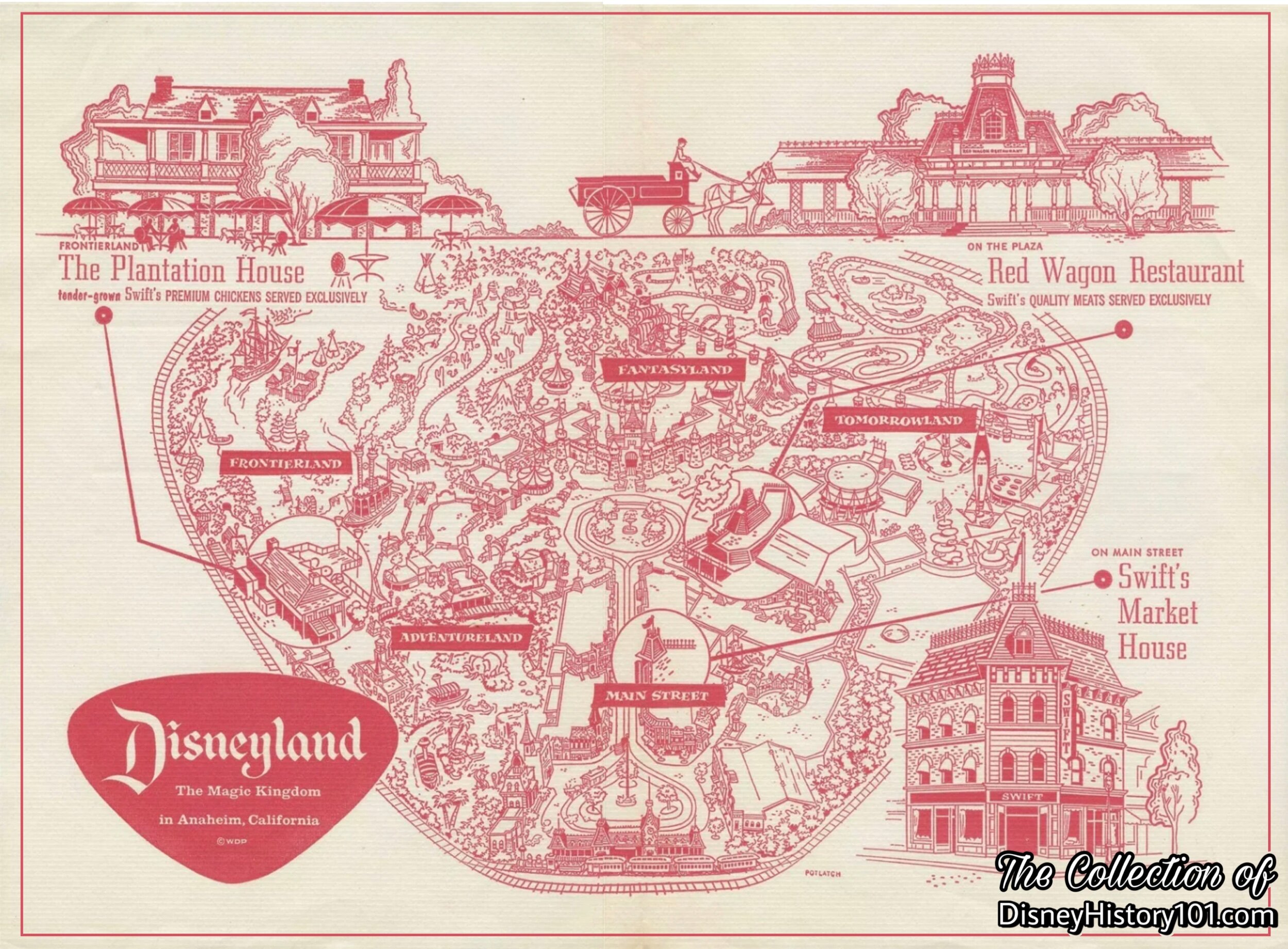
Swift’s Souvenir Menu Highlighting All Disneyland Locations Where Swift's Products Were Offered
Artwork (bearing the other Swift’s Disneyland locations) could also be found on Food Service Trays. You may remember enjoying this art so much, and taking home one of the souvenir menus or paper placemats which featured the same graphics.
Other souvenirs included those complimentary toothpicks (in sealed paper packaging), and matchbooks advertising Disneyland restaurants were a common sight (especially during the years that the Tobacco Shop was a fixture on Main Street U.S.A.). This was especially commonplace during the later years that Disneyland owned and operated the Tobacco Shop.
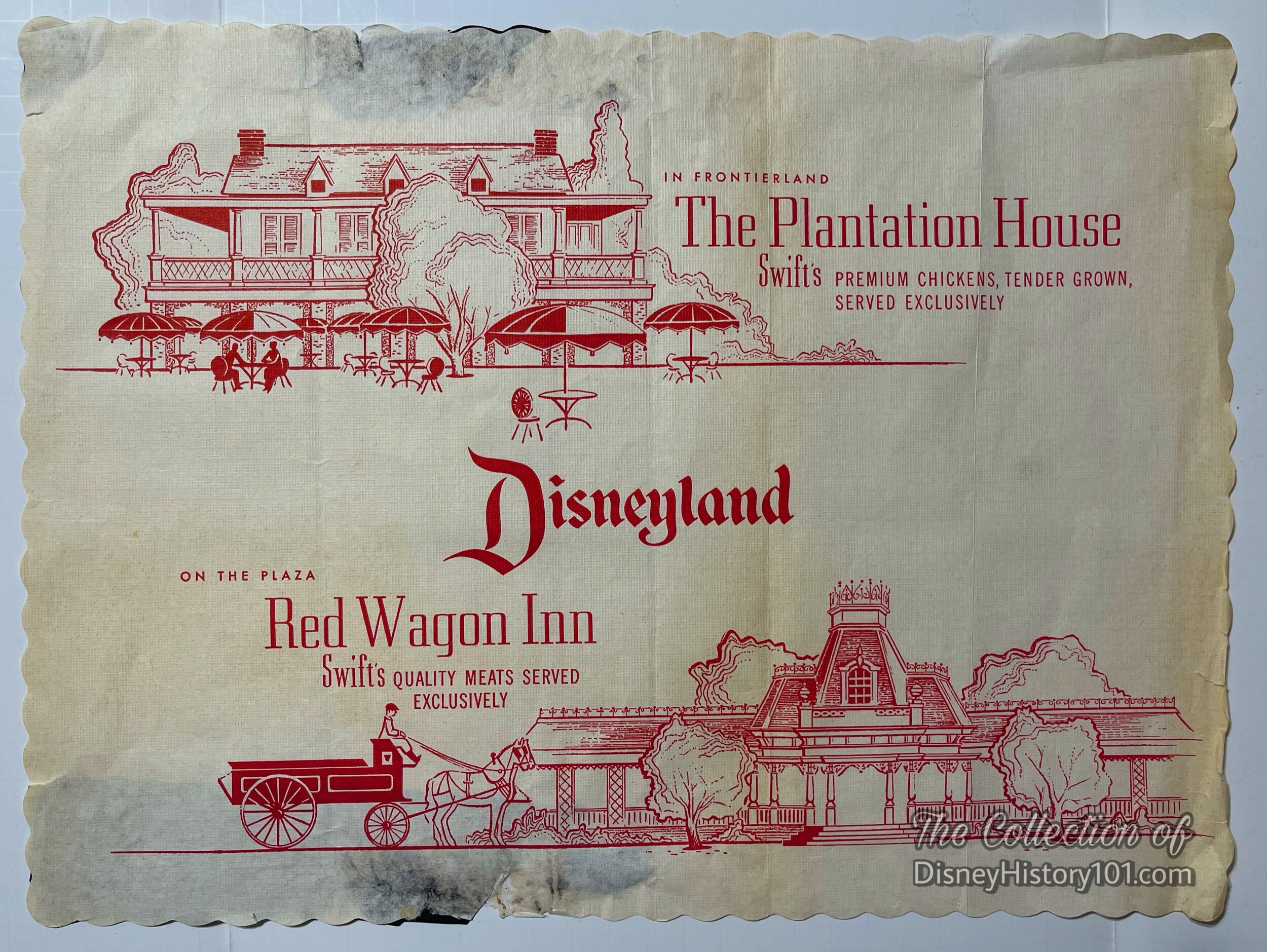
Disneyland Menu Highlighting the Two Swift's Dining Locations - Red Wagon and The Plantation House Menu
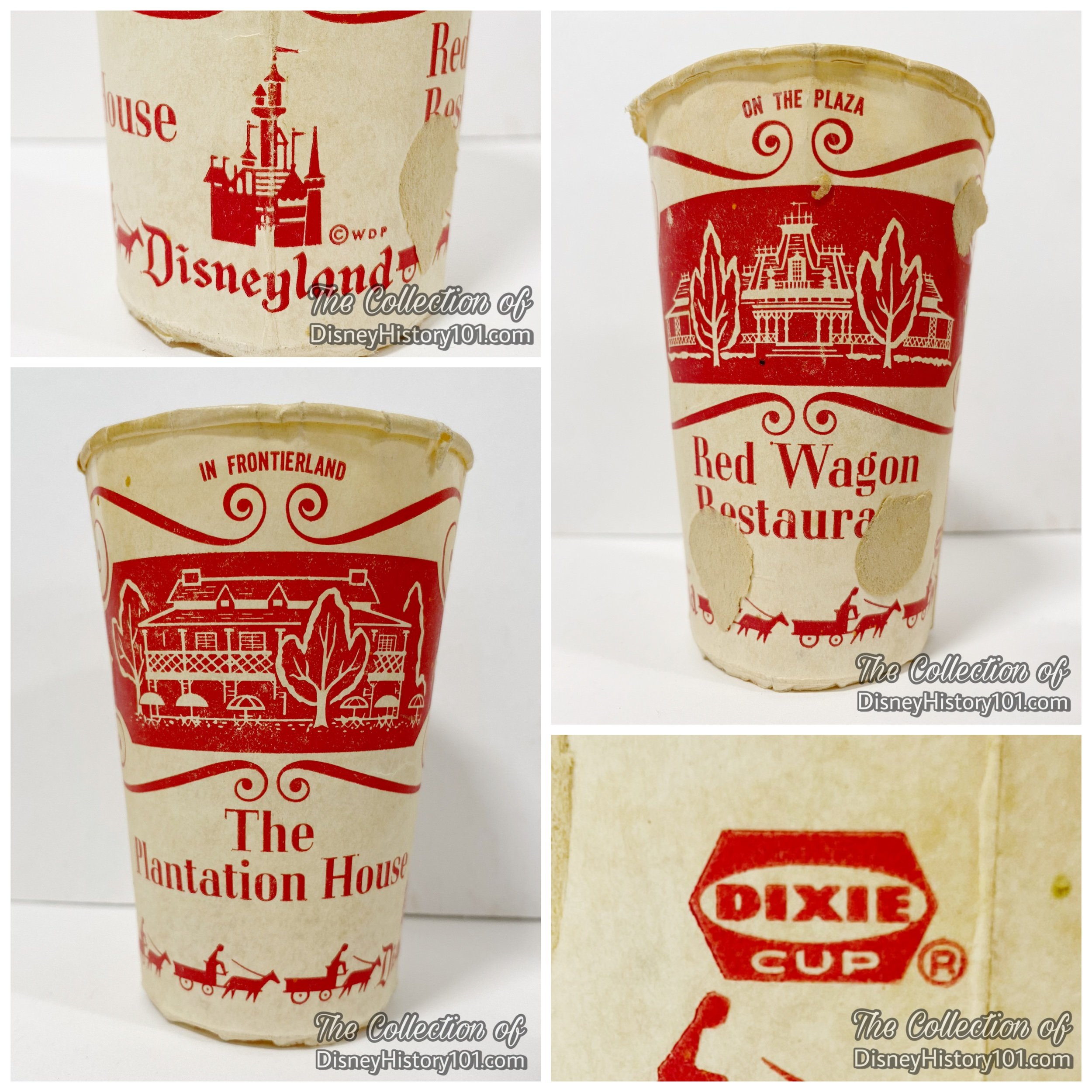
A Plantation House and Red Wagon Restaurant cup by Dixie Cup.
The DIXIE CUP division of the American Can Company opened the doors of their Anaheim facility in 1952. The neighboring business came to be located at 901 E. South St., Anaheim, Cal. With a staff of nearly two hundred people under the direction of J.D. Mitchell, the center operated as a manufacturing and distribution point for their product quality paper cups to seven of the Western States.
The business partnership between Disneyland, Inc. and the Dixie Cup Company was profitable. By September of 1958, the Dixie Cup Company was contributing a routine portion of accounts receivable to Disneyland, Inc.
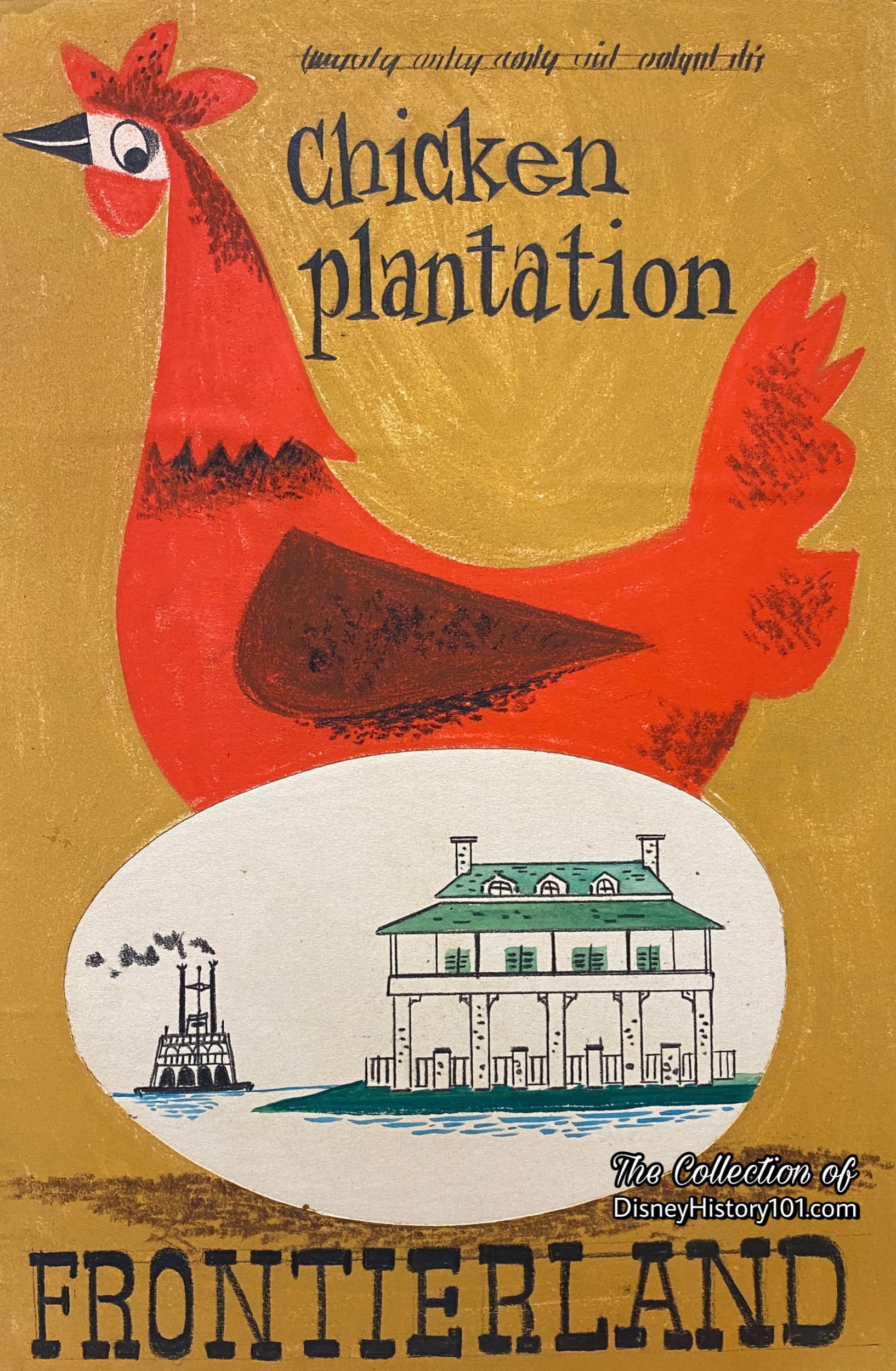
Concept art for the Chicken Plantation at Disneyland Park® poster.
According to “Disneyland Attraction Posters: 40 Years of Visual Adventure” by Margaret Shumate, published in Walt Disney Collector Society “Sketches” periodical: “With his usual attention to every detail of his beloved park, Walt Disney personally reviewed and approved each finished piece of poster art until his death in 1966.”
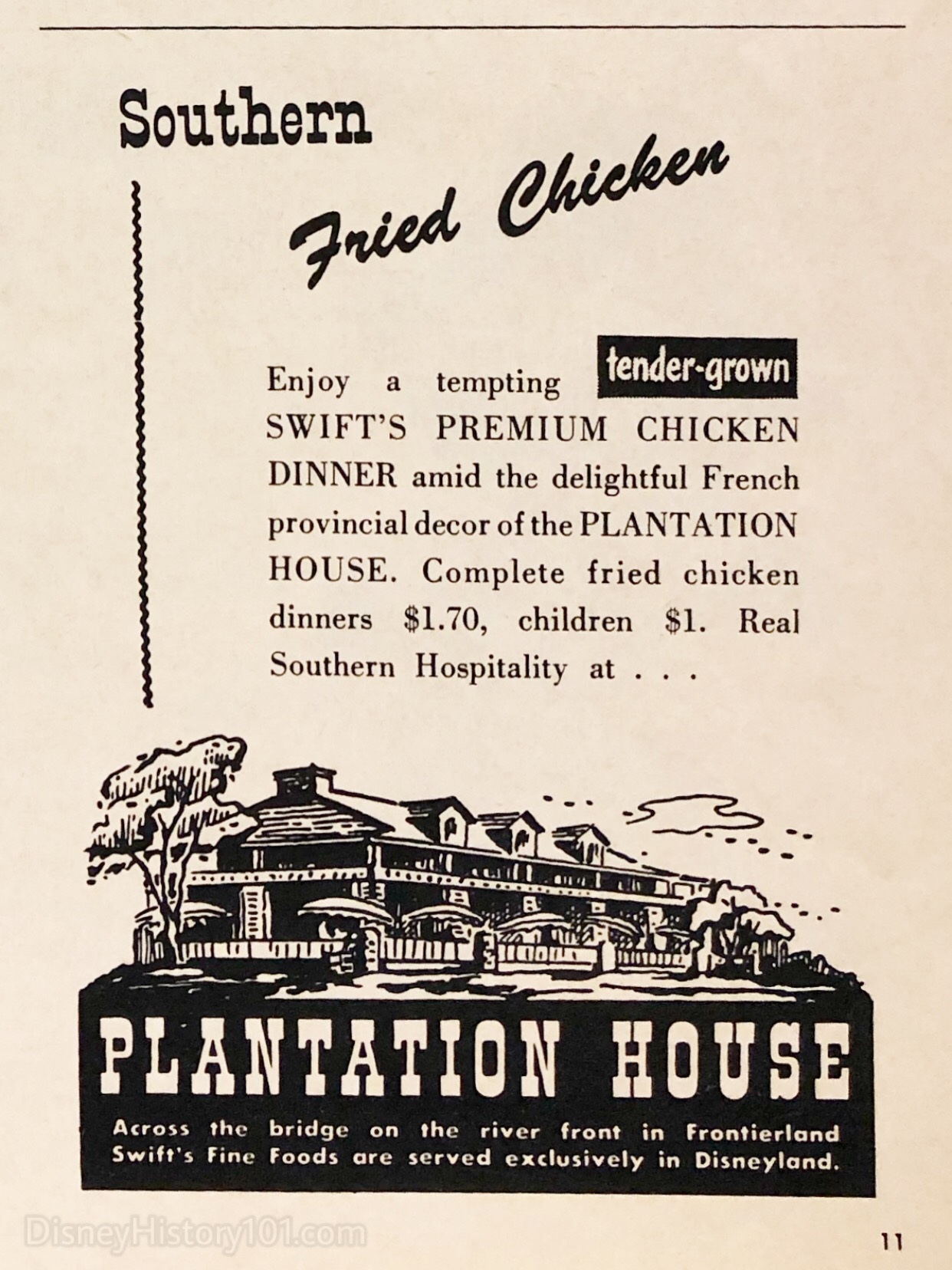
Disneyland Holiday magazine advertisement, winter, 1957 - 1958.
These could be enjoyed during the daytime or even during Date Nites (perhaps beginning around the Summer of 1961) while The Arvon Dale Orchestra performed nearby!
By the summer of 1957, Complete Fried Chicken Dinners and all the southern hospitality cost $1.70 for adults and $1.00 for children. Members of Disneyland Operations regularly held meetings at the Chicken Plantation Restaurant. For instance, the Holiday Land Picnic Committee held a meeting here Wednesday, April 10th, 1957, to discuss “problems of operations and sales.” [Disneylander, May of 1957, page 8] Decades later, Dick Nunis (in response to inquiry about his favorite part of Disneyland which is no longer there) shared : “I miss the old Chicken Plantation where I spent many Sundays sitting with Walt talking about the future of Disneyland. I remember one day the Mark Twain was coming around the bend, a Keel Boat was coming in, a Keel Boat was leaving, two rafts were crossing the River, two Indian War Canoes were racing each other, and Walt said, ‘Look at that, that’s a great show. What we need is another boat. And that’s when we decided to build the Sailing Ship Columbia.” (according to Disneyland LINE, Vol.25, No.28, published July 16th, 1993)
As a sidelight, by October 1959, Jim Baker (of Merchandising) was overseeing the Disneyland Food Administration and Souvenir Sales. By October of 1959, the company was (1) of over sixty-eight other firms playing a vital part in the team effort to bring happiness to Disneyland’s Guests. Some were small, specialized individual operators; some were huge companies such as Swift & Co. - the Bank of America - United Paramount Theaters (which you hear as UPT) - Carnation - Richfield - General Dynamics - Crane - and many others. These companies used the park to publicize their wares, leased space in the Park to sell their wares, and Disneyland collected advertising fees from them.
By 1960, Disneyland wasn’t the only theme park with a Chicken Plantation Restaurant. Freedomland had a Chicken Plantation Restaurant sponsored by J. D. Jewell, Inc.
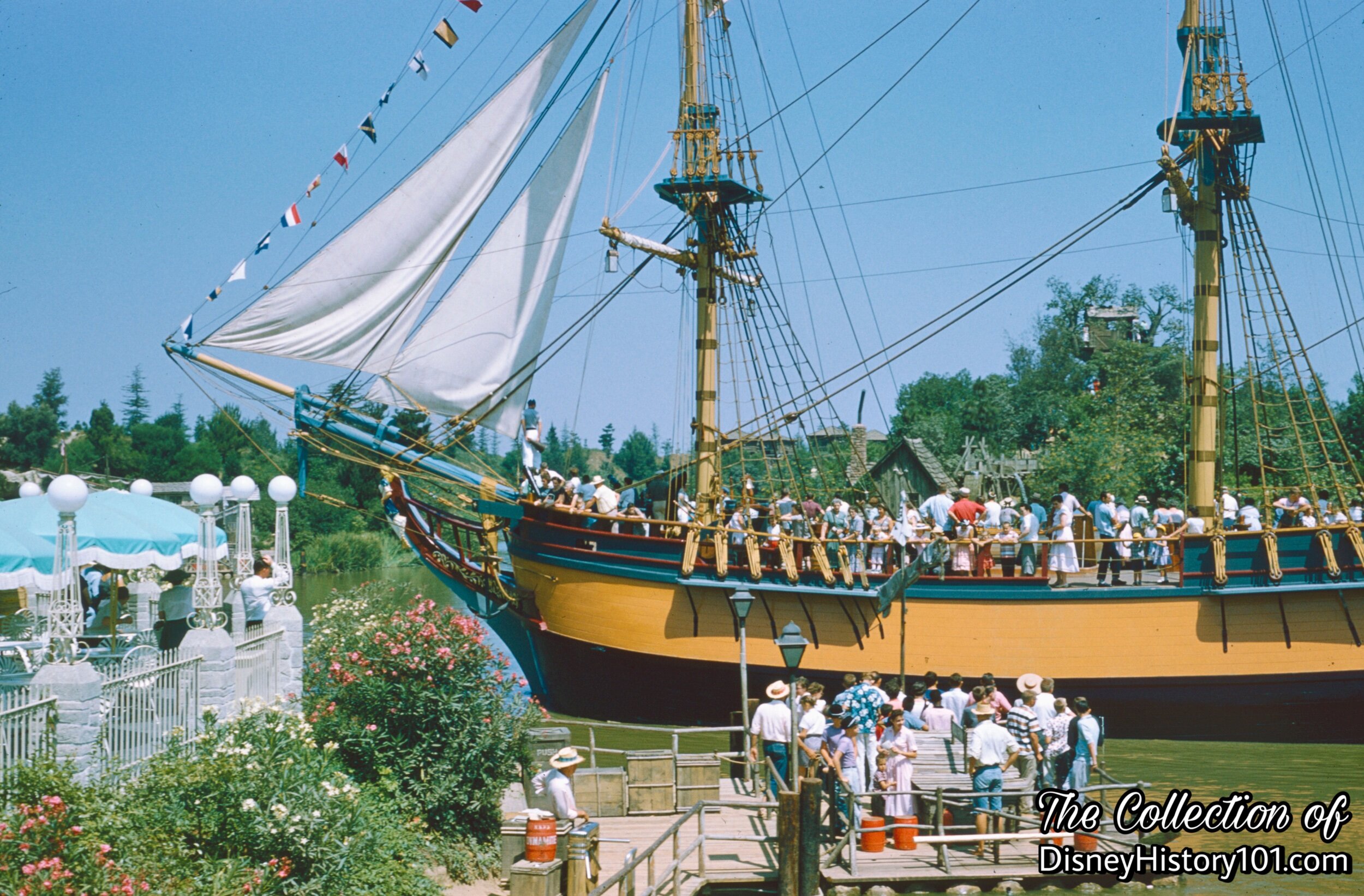
Chicken Plantation Restaurant Patio (left) grants views of passing water craft
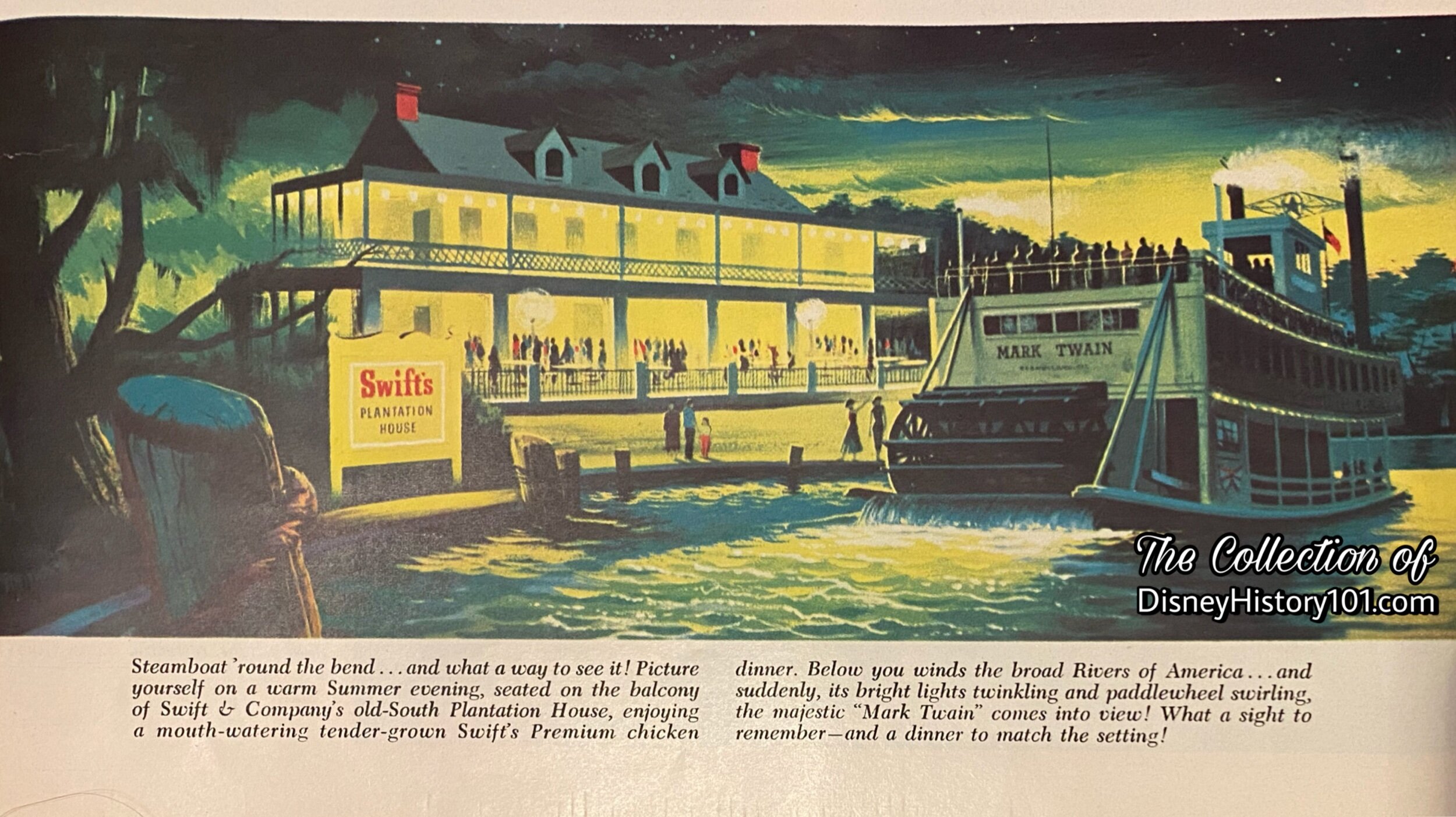
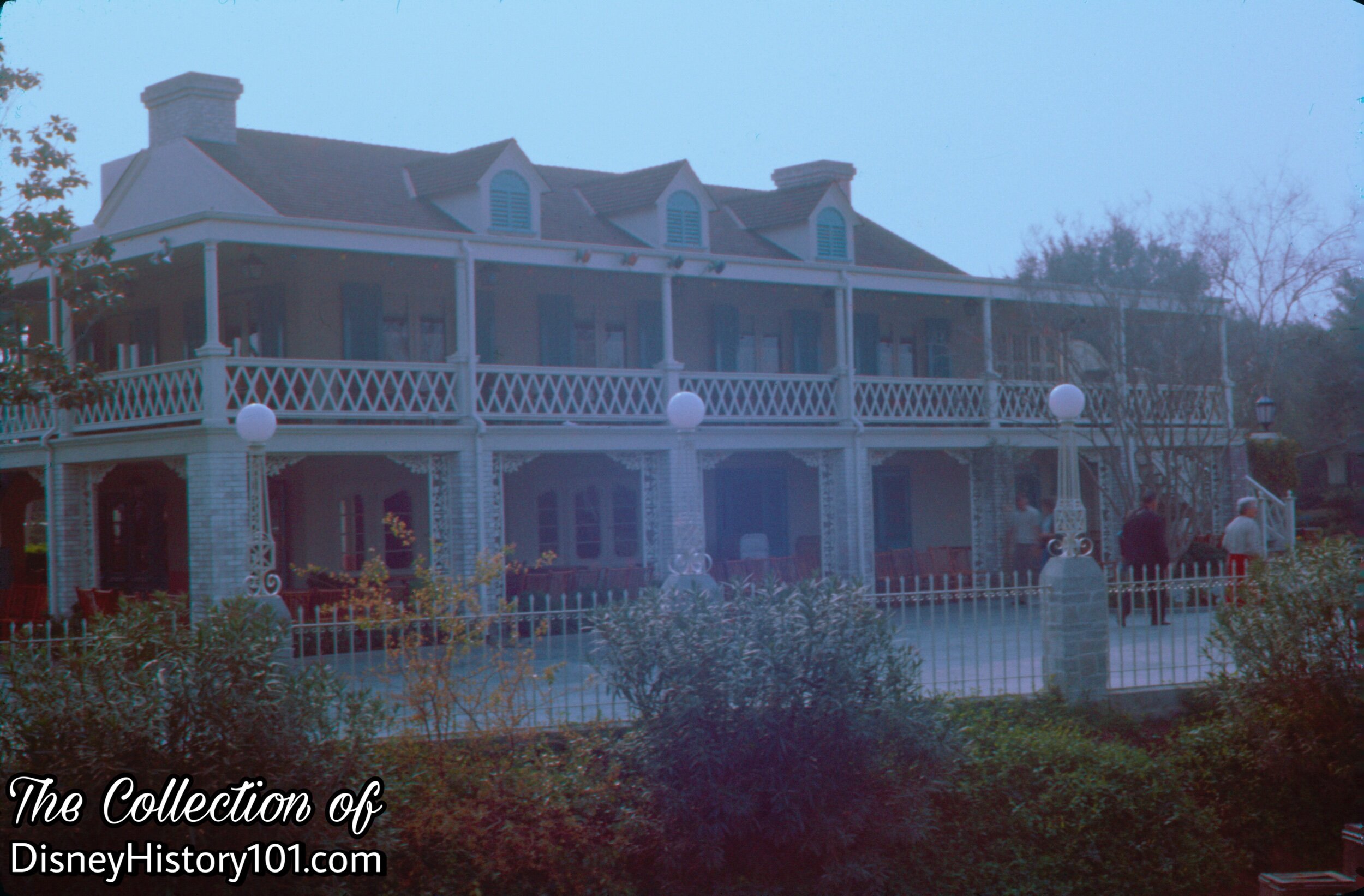
The Chicken Plantation Architectural Facade or Front of House, March, 1960.
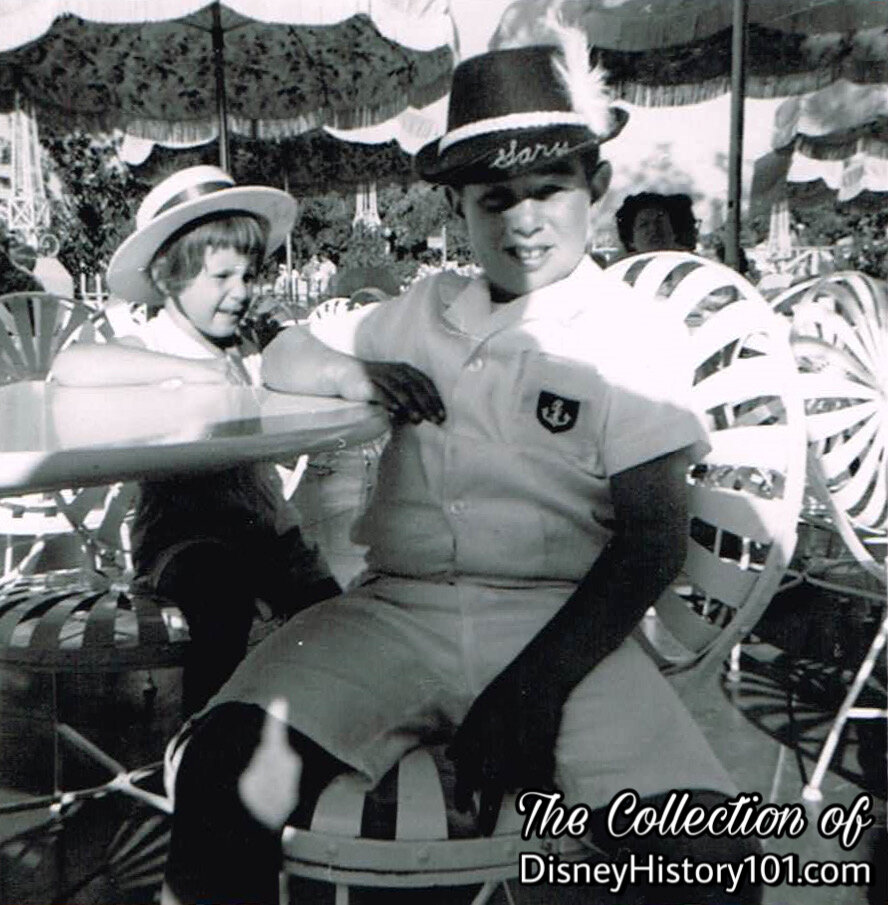
Guest on the Chicken Plantation Patio
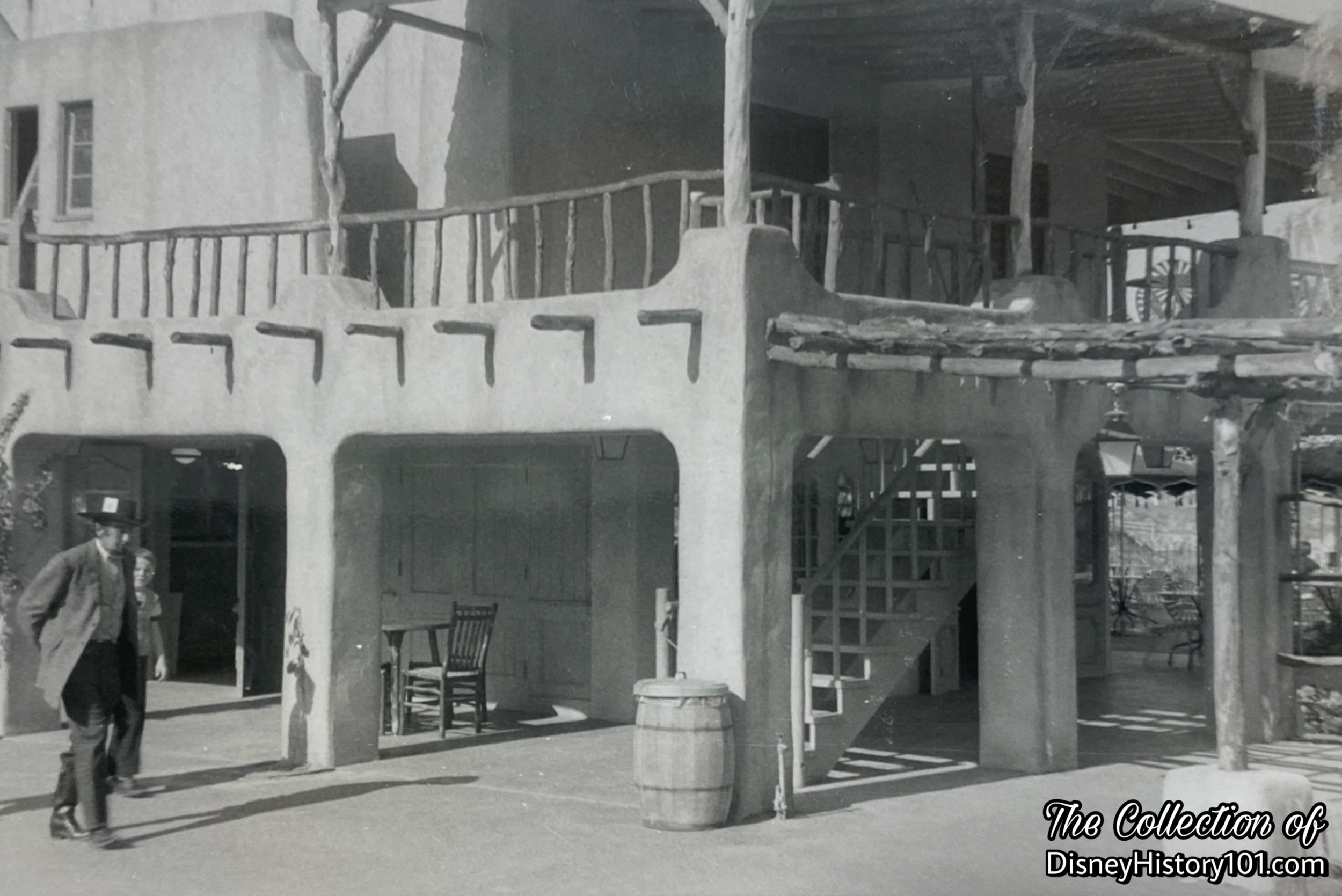
Black Bart the "Crooked Gambler" strolls behind the Chicken Plantation.
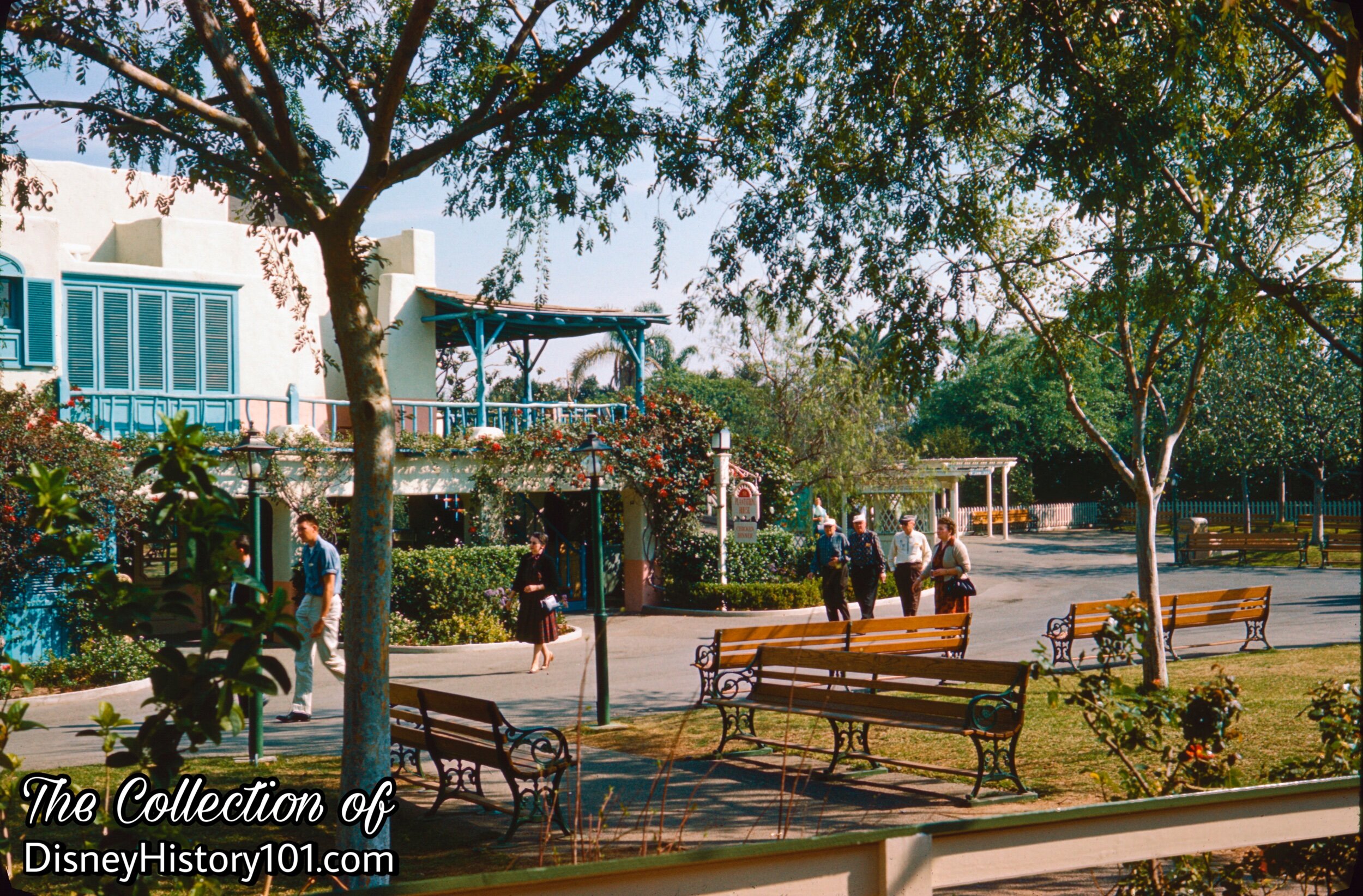
The Plantation House on Orleans Street
This was the view from Frontierland Station (located behind the Chicken Plantation). The park-like setting provided a picturesque slice of Frontierland for guests to relax and enjoy the tempting scent of fried chicken dinners.
The synergistic relationship between the institutional lessee and Disneyland was beneficial. Swift and Company and the Plantation House yielded some revenue for Disneyland Inc. - $24,058 for the fiscal year ending September 29, 1957 and $21,950 for the fiscal year ending September 28, 1958. By September 28, 1958, Disneyland, Inc. made approximately $114,162.00 of land improvements to the Chicken Plantation.
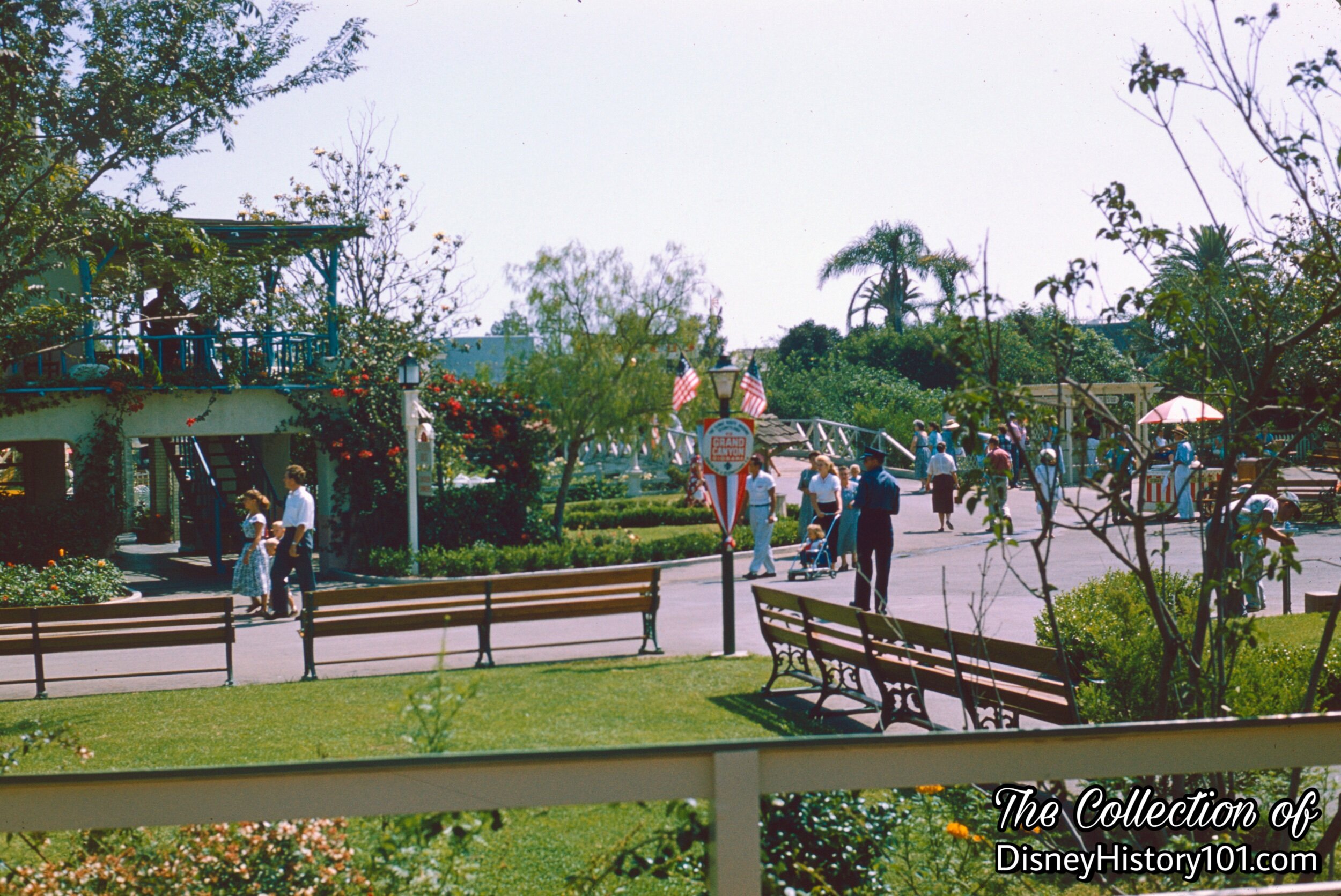
Swift's Chicken Plantation Restaurant (Rear)
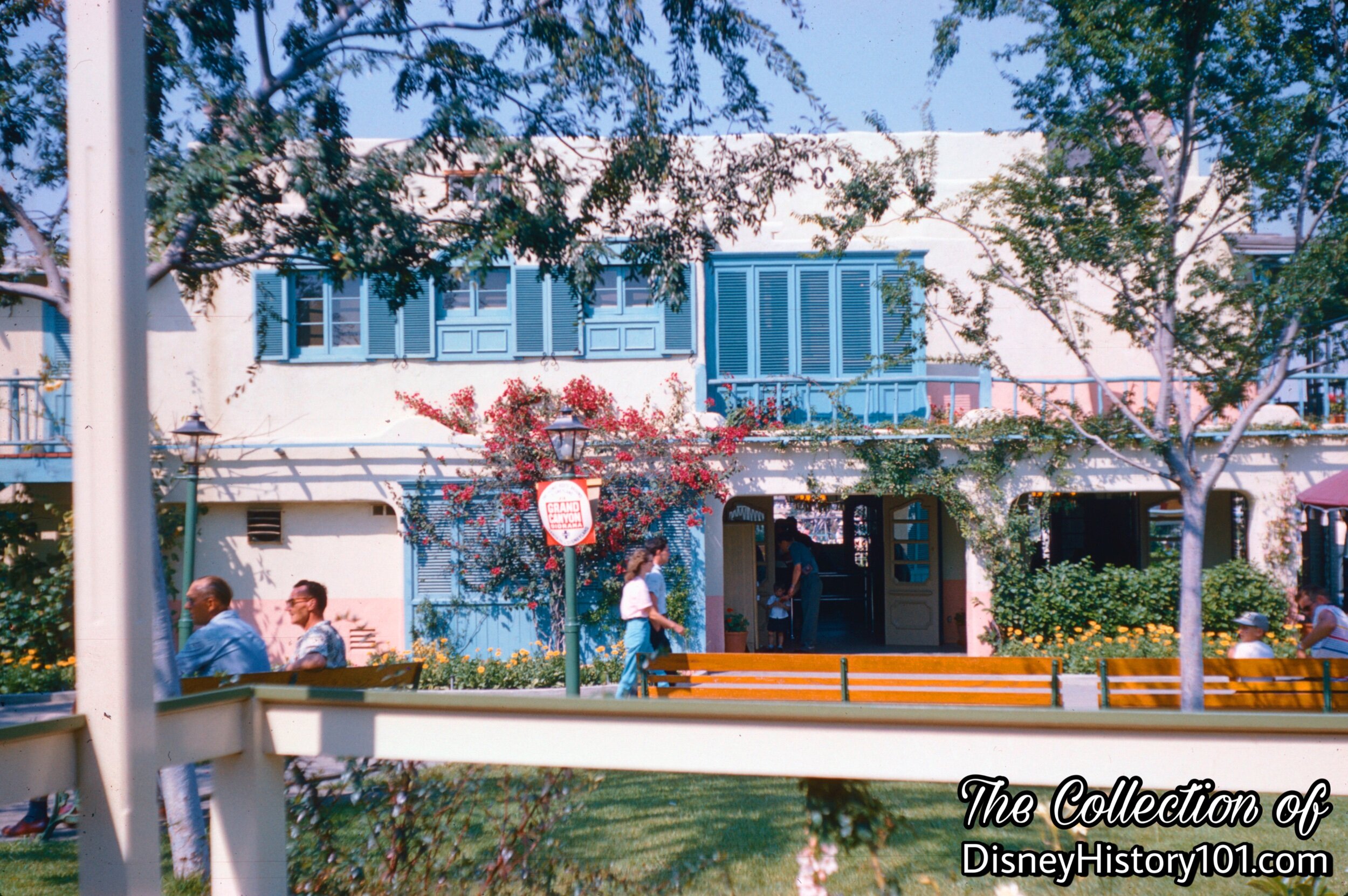
Swift's Chicken Plantation Restaurant “Back of House” (Rear), 1958.
This was the scene as Guests awaited passage to the Grand Canyon Diorama, aboard the Santa Fe & Disneyland Railroad’s freight train. That flowering Bouganvillea (left of the Chicken Plantation entrance) was likely selected by the legendary team of landscape architects and horticulturalists - Ruth Patricia Shellhorn and Jack & Bill Evans! It seemed to be a popular attraction with Guests, because many people took pictures of it over the years!

The Australian tea tree (Leptospermum laevigatum) near the rear of Swift's Chicken Plantation Restaurant.
One bougainvillea was in fact a composite “flowering tree,” located behind the Chicken Plantation. An Australian tea tree (Leptospermum laevigatum) tree became an unfortunate casualty of transplanting. The skeleton was salvaged and converted into a unique natural sculpture with the aid of a scarlet colored bougainvillea.
Cal McMurtrey recalled “The Chicken Plantation House was a great place for girl watching… I was a gardener then, and I was taking care of Magnolia Park and the grounds around the old Plantation House. I remember the good lookin’ girls that would come by..the prettiest I had ever seen. I tried to meet my fair share of them...I WAS SINGLE THEN!”
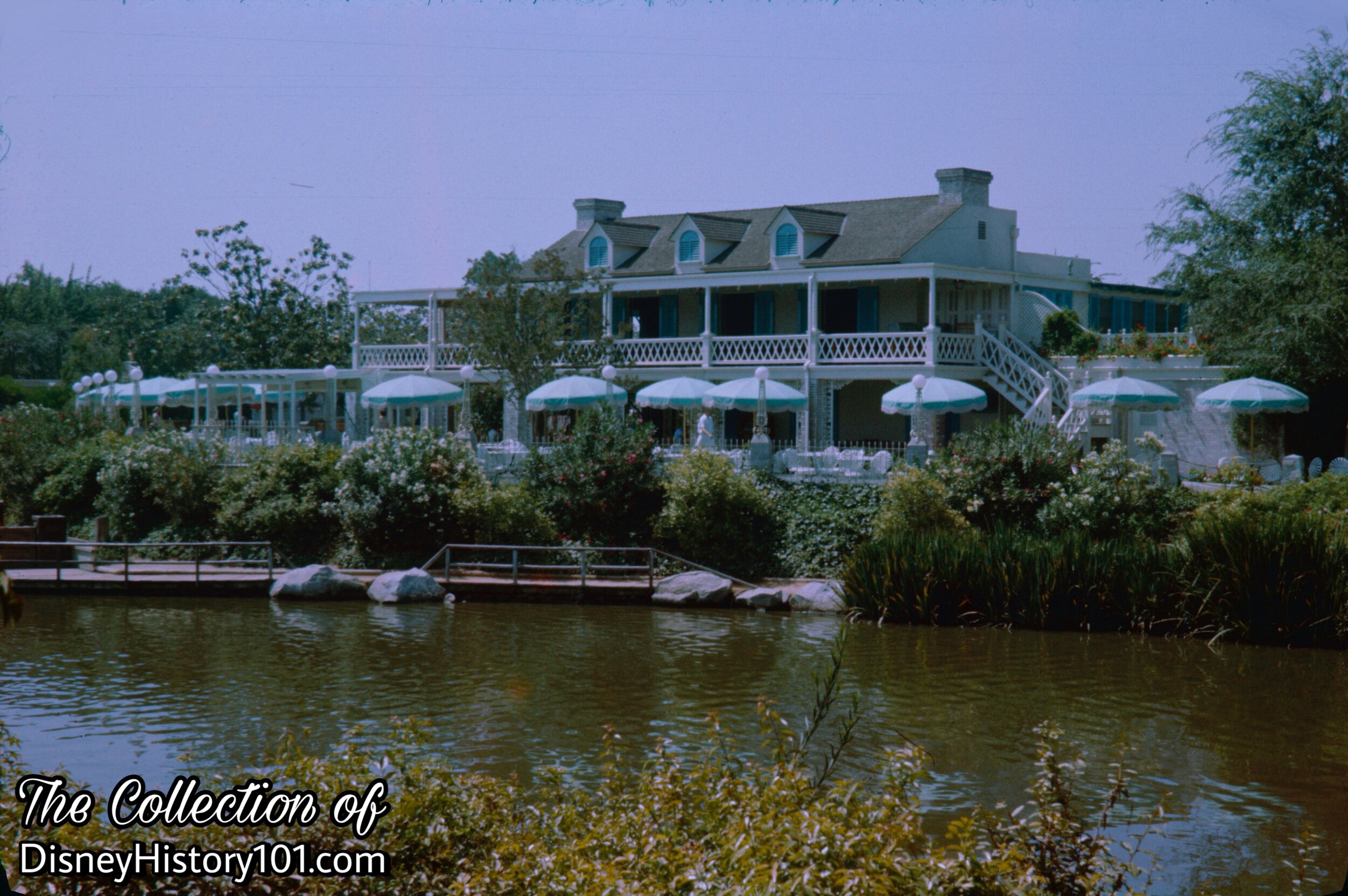
The Chicken Plantation, 1961.

Chicken Plantation Restaurant, October, 1961.
“Songs of the South”
Music, as a basic ingredient of showman-ship, covers the Park. The Dixieland Band Stand (also called Orleans Bandstand) provided live entertainment within earshot and sight of the Chicken Plantation Restaurant. Dining could be enjoyed during the daytime or even during Date Nites (perhaps beginning around the Summer of 1961) while The Arvon Dale Orchestra performed nearby! The First Frontier Nite at Disneyland offered western music behind the Plantation House, on Tuesday nights through the summer season of 1961.
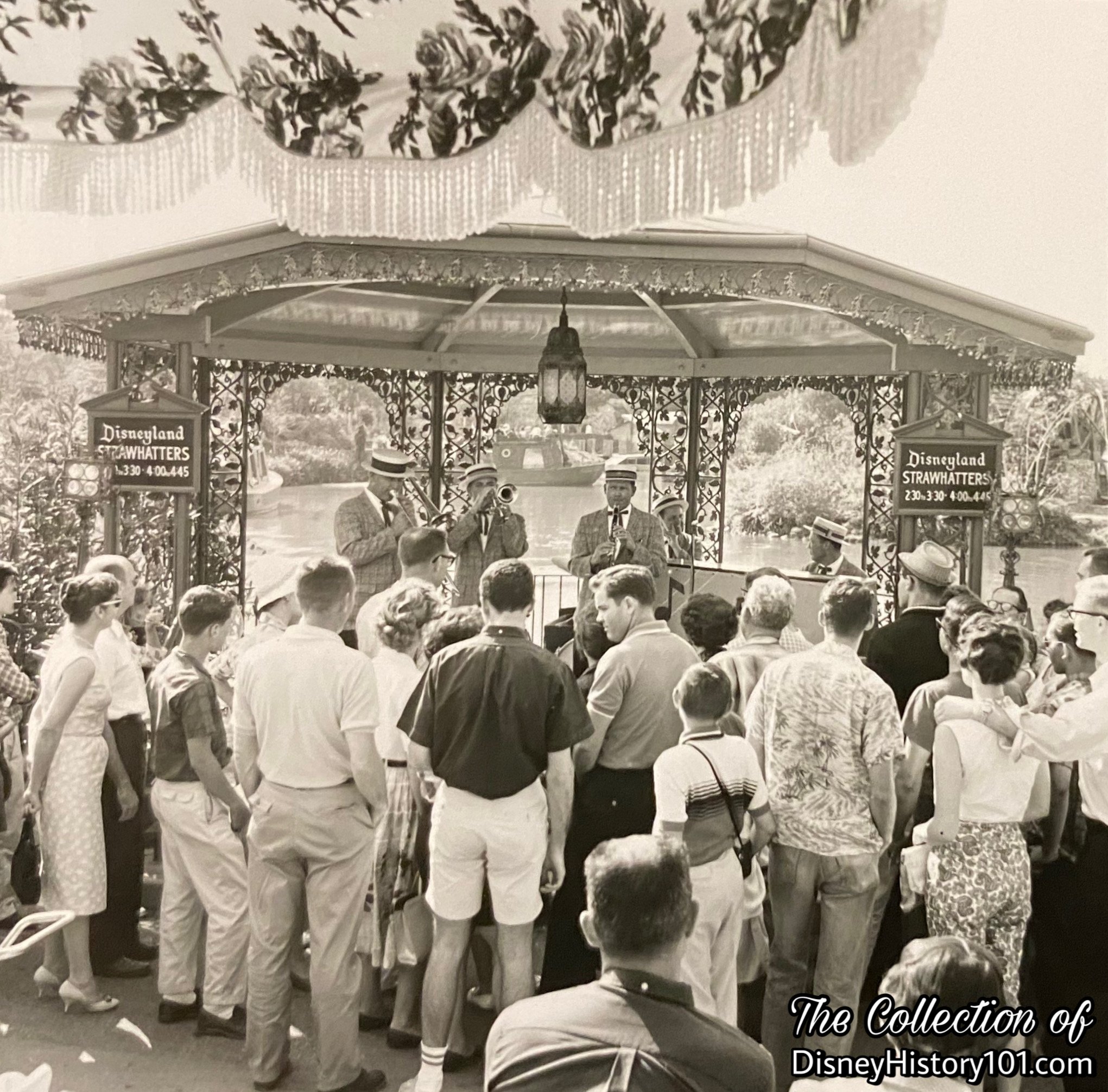
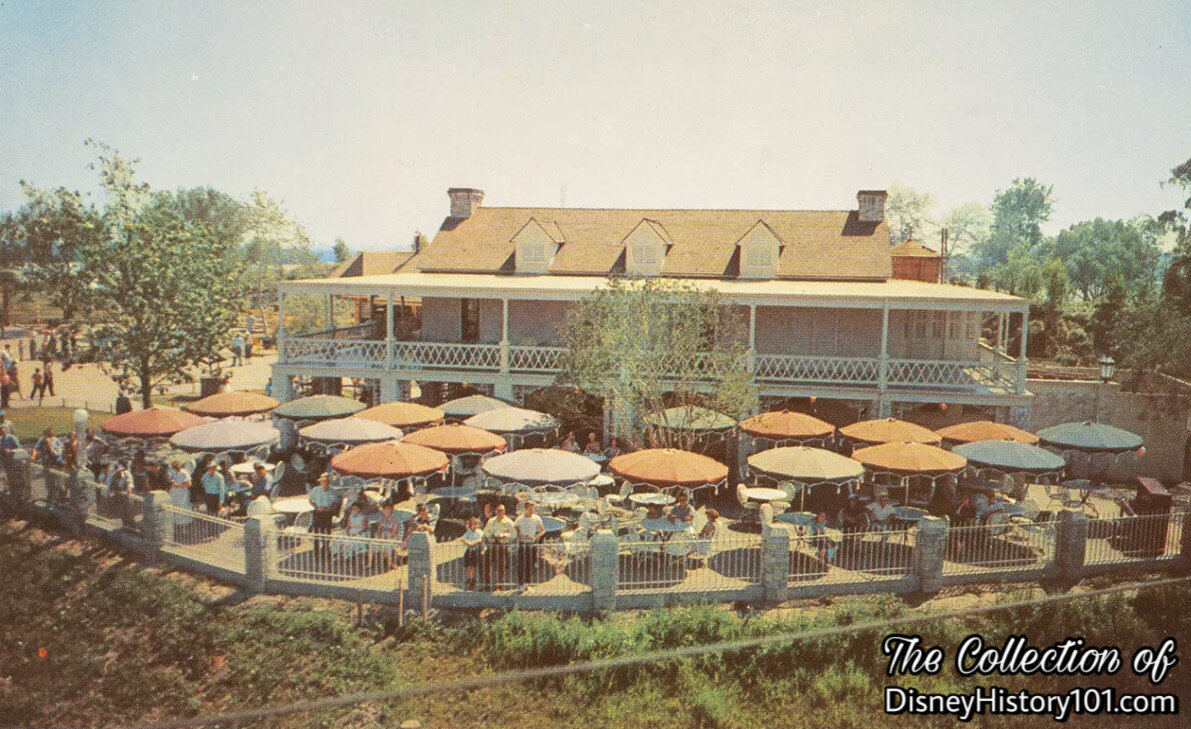
Chicken Plantation Postcard
Postcards would preserve the Chicken Plantation (and it’s riverfront patio) the way that it is best remembered.
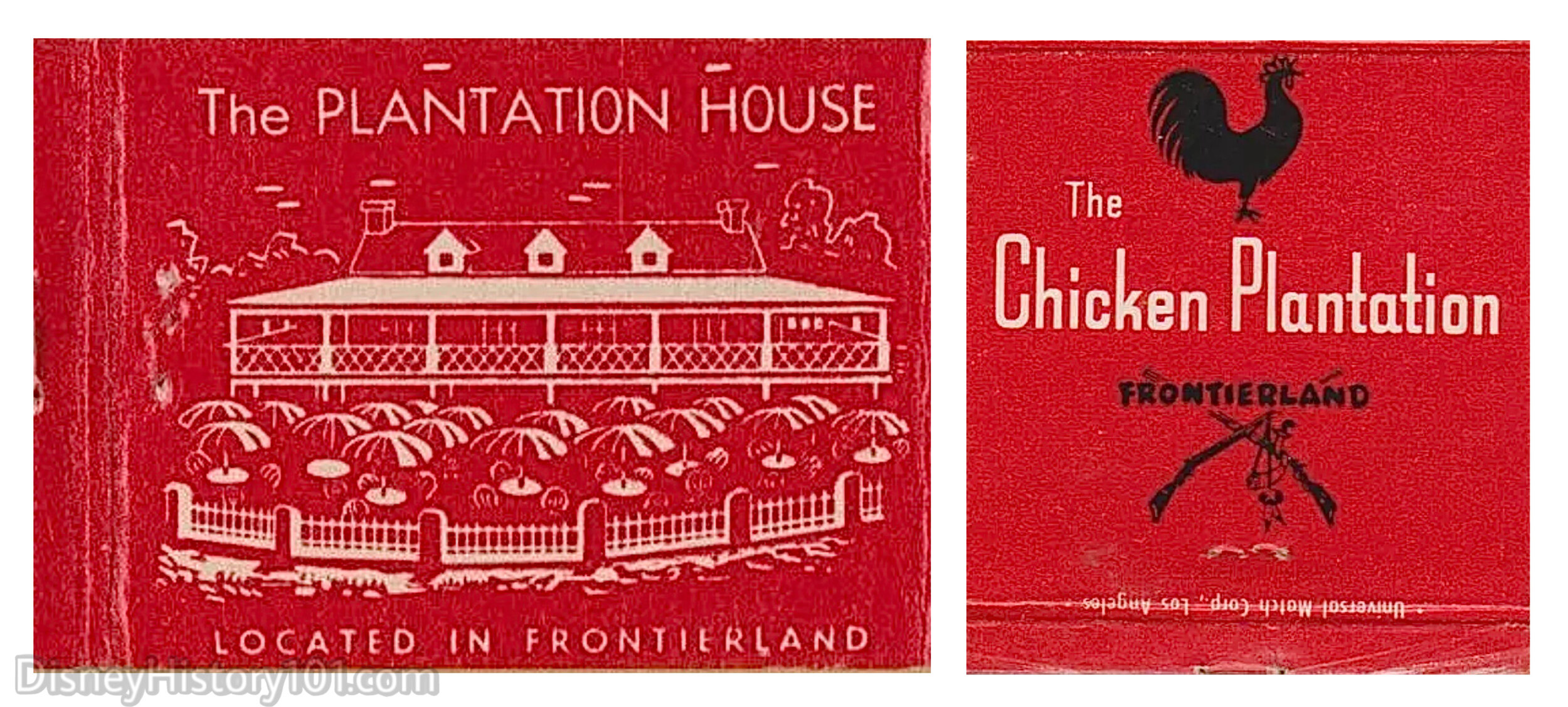
Matchbook Covers advertising the “Chicken Plantation” and “Chicken Plantation House”, c. 1955 - 1962
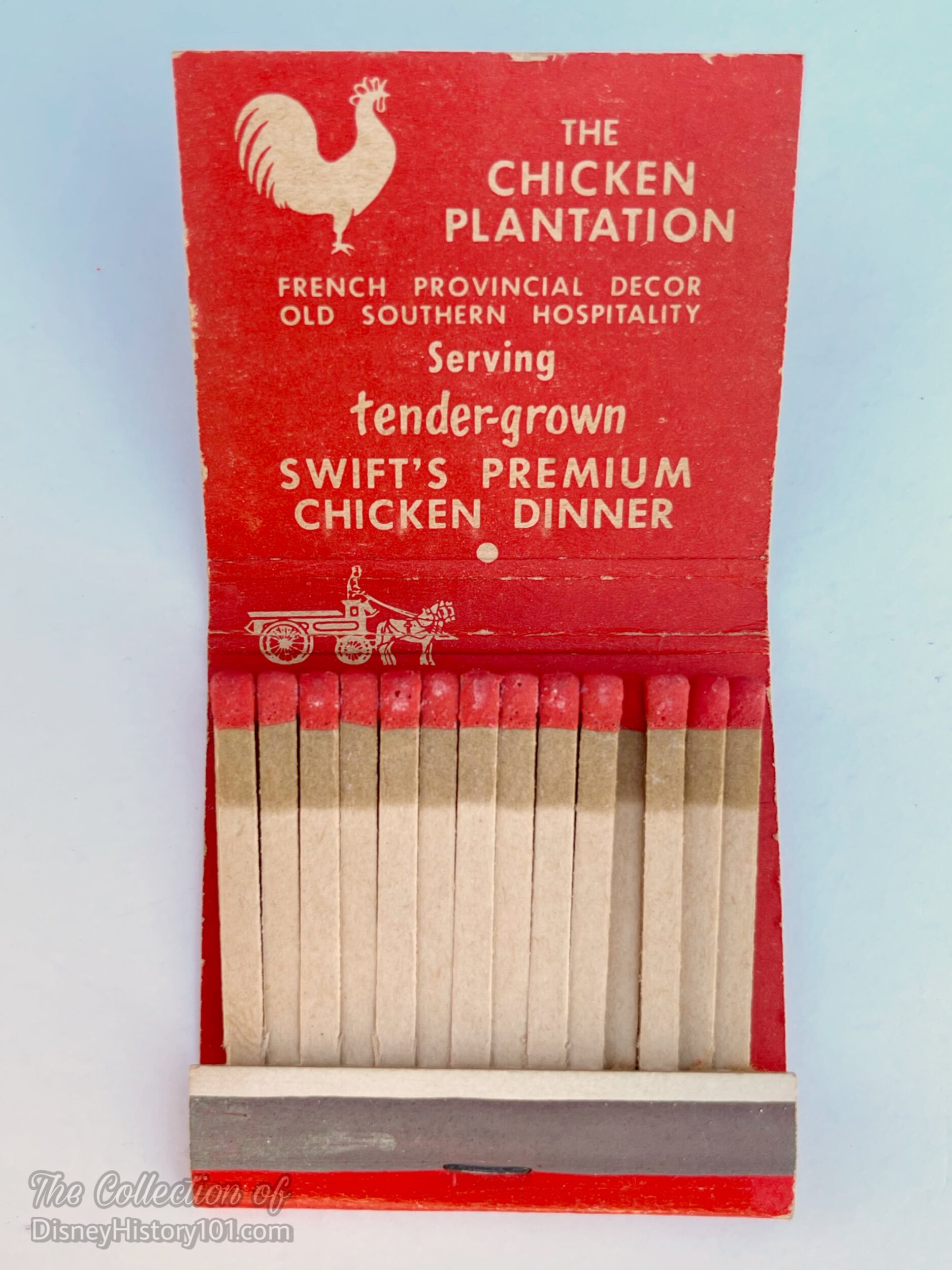
Matchbook Covers advertising the “Chicken Plantation” and “Chicken Plantation House”, c. 1955 - 1962
At least these two cover styles were produced - one bearing a chicken and the other, a graphic of the restaurant and patio. Complimentary matchbooks (bearing the names of Disneyland and their corporate sponsored restaurants) were fantastic pieces of promotional souvenirs, allowing Guests the opportunity to “strike up” conversations about Disneyland while outside the Park!
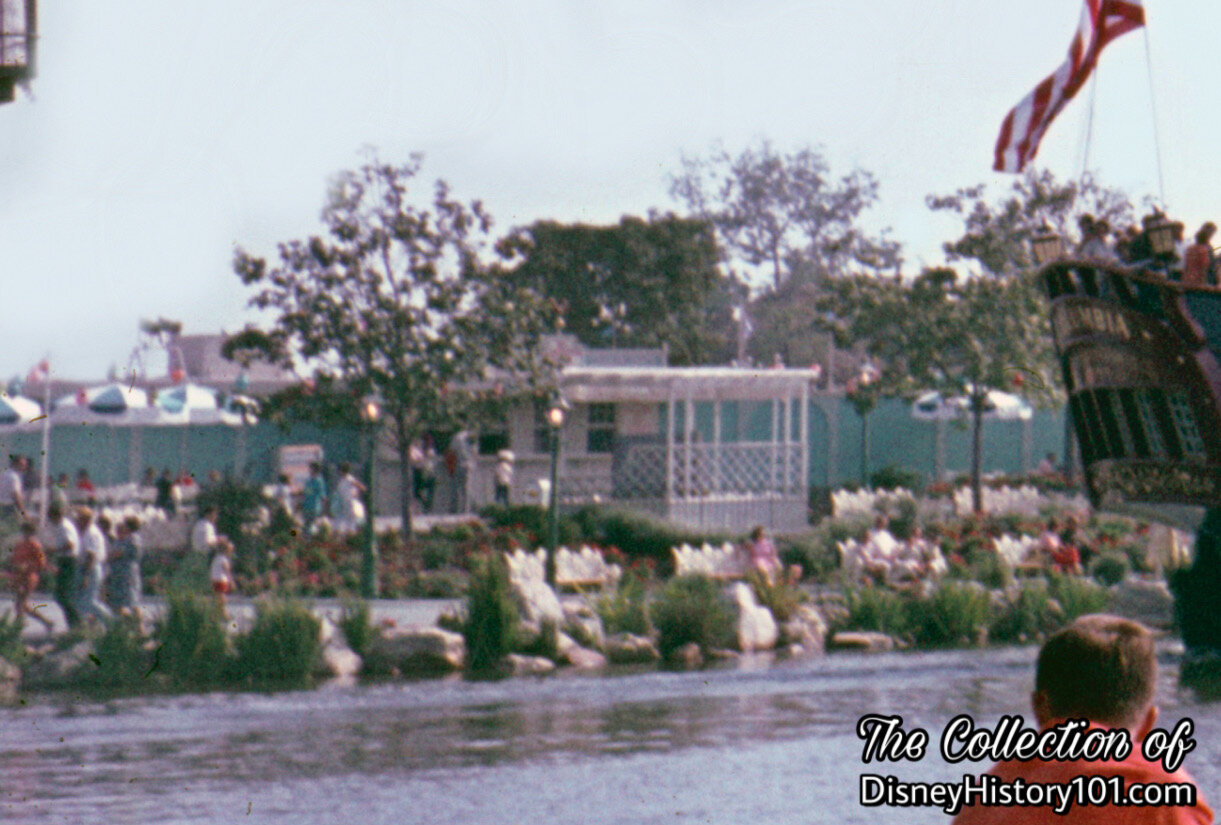
Construction Wall
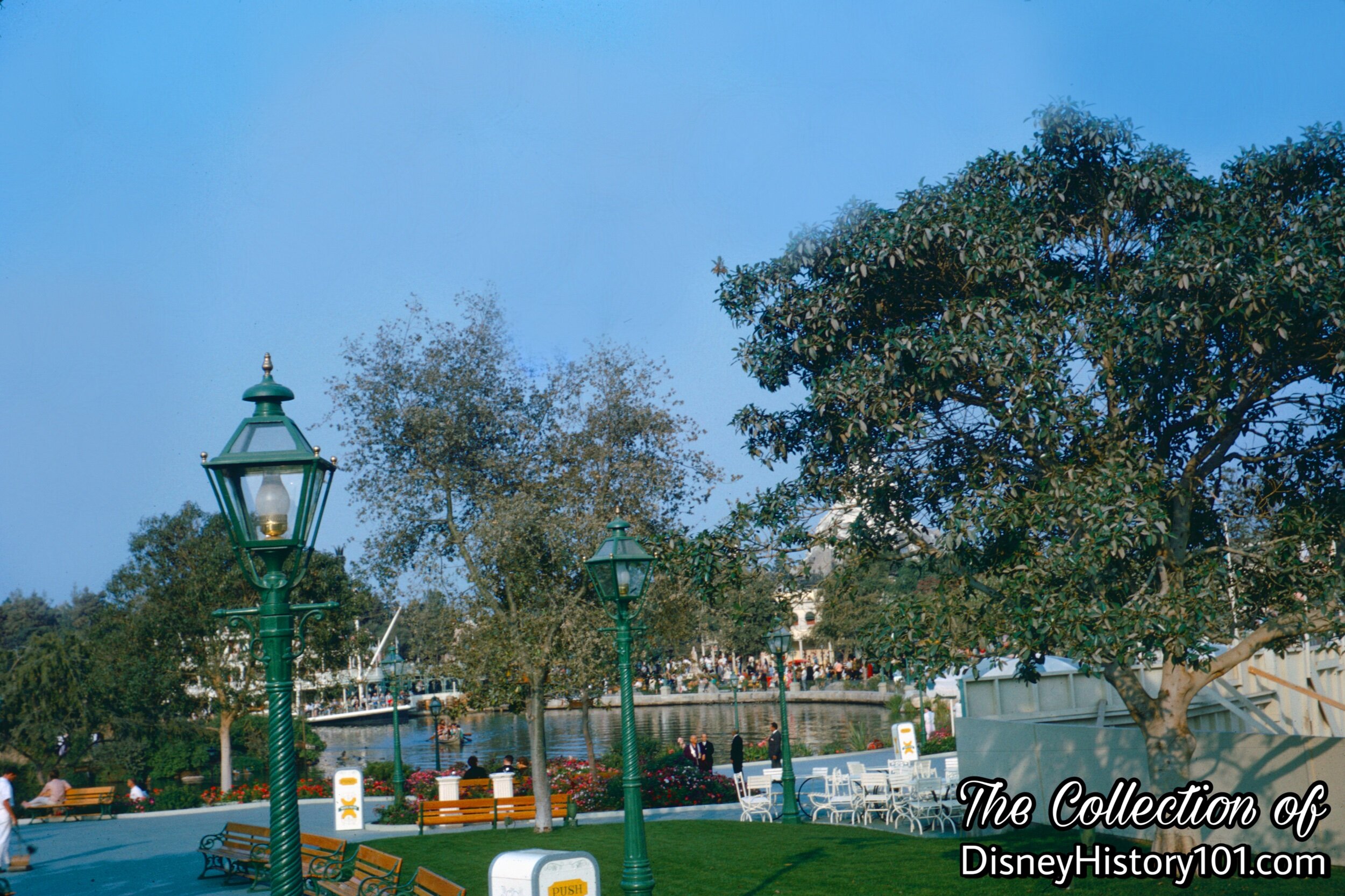
Near Former Location of Swift's Chicken Plantation Restaurant
Walt once said that “Disneyland is like a piece of clay : if there is something I don’t like, I’m not stuck with it. I can reshape and revamp.” A fantastic example is this little river side stretch of Frontierland that originally spanned Orleans Street. Some of the earliest (c.1957) artwork produced for the “Old South” area of Frontierland involved centering the “Pirate Wax Museum” and other attractions around the Chicken Plantation Restaurant. However (in 1962), developments of new Disneyland adventures along the Rivers of America would lead to the Chicken Plantation Restaurant closing for good.
During 1961, Eleanor Heldt (Magic Kingdom Club Administrator) commented that “During a major rehabilitation, it is sometimes necessary to close an attraction for several weeks. This, of course, is when the smallest details were checked, replaced or repaired as required for the maximum safety, convenience, and comfort for our guests.” The restaurant closed January 8th, 1962, but for no major rehabilitation. The Chicken Plantation would not reopen, but be razed to the ground that very month. The Chicken Plantation can readily be seen preserved on color film, in some aerial footage of “Disneyland, U.S.A.” (a “People and Places” feature film, released in the U.S. on December 20, 1956 through Buena Vista Film Distribution Company).
But, Walt Disney’s Imagineers knew their audience. For those guests who would long to sit along the romantic Rivers of America and enjoy a chicken dinner, the location’s spirit would live on (not far away) in New Orleans Square’s Blue Bayou (another river front restaurant)!
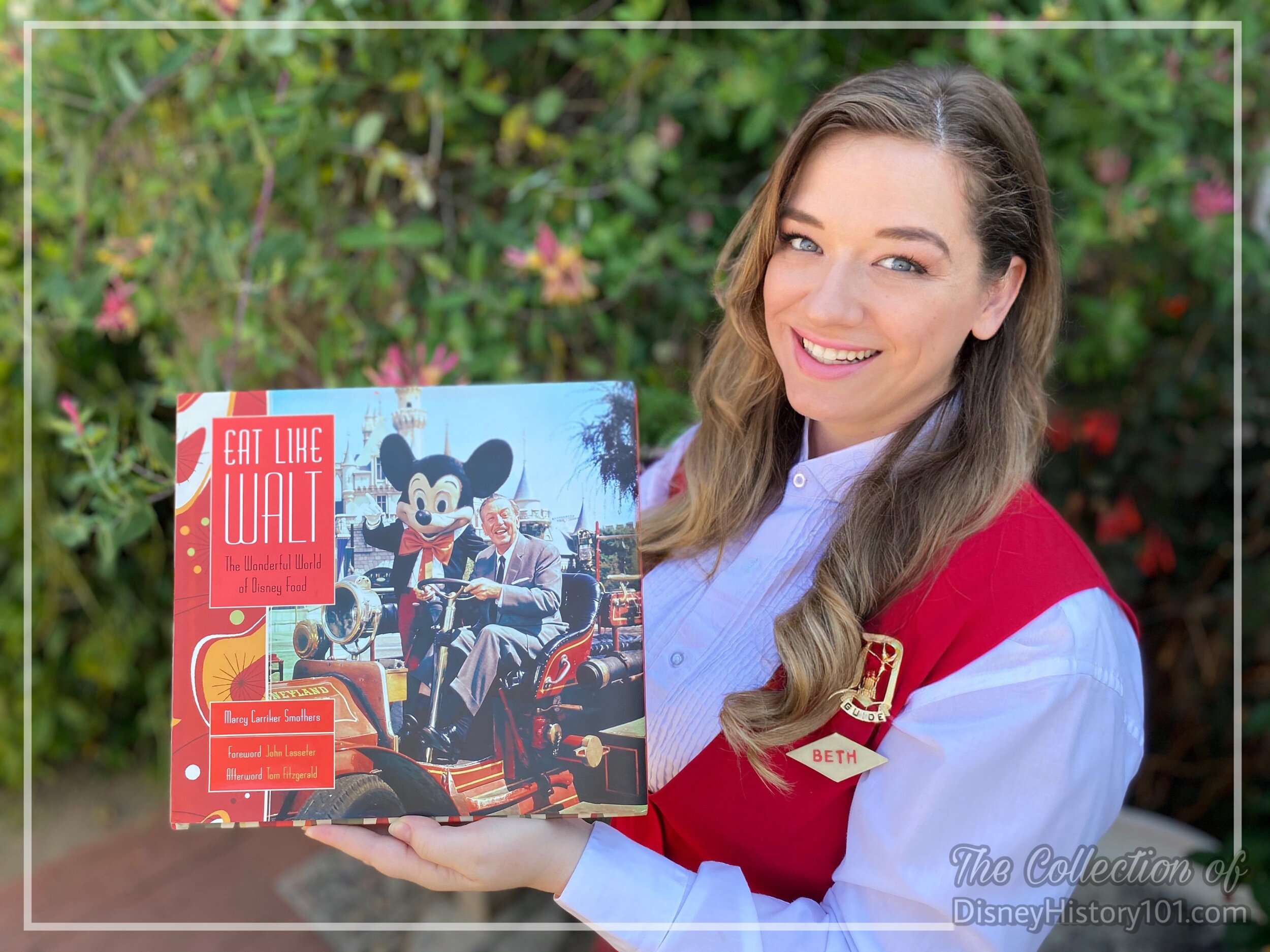
If you would like to read more about the Swift’s Chicken Plantation, it’s my pleasure to recommend adding Marcy Smothers’ “Eat Like Walt - The Wonderful World of Disney Food” to your personal Disney Home Library! Therein, Marcy has extensively researched and finely crafted a small section of a chapter dedicated to “Walt Disney’s Disneyland - Frontierland” If you would like to bring the magic of Disneyland restaurants and concessions to your dining room table, “please step this way” toward www.eatlikewalt.com where Marcy has shared a few recipes for memorable Disneyland menu options, so you too can “Eat Like Walt.”
